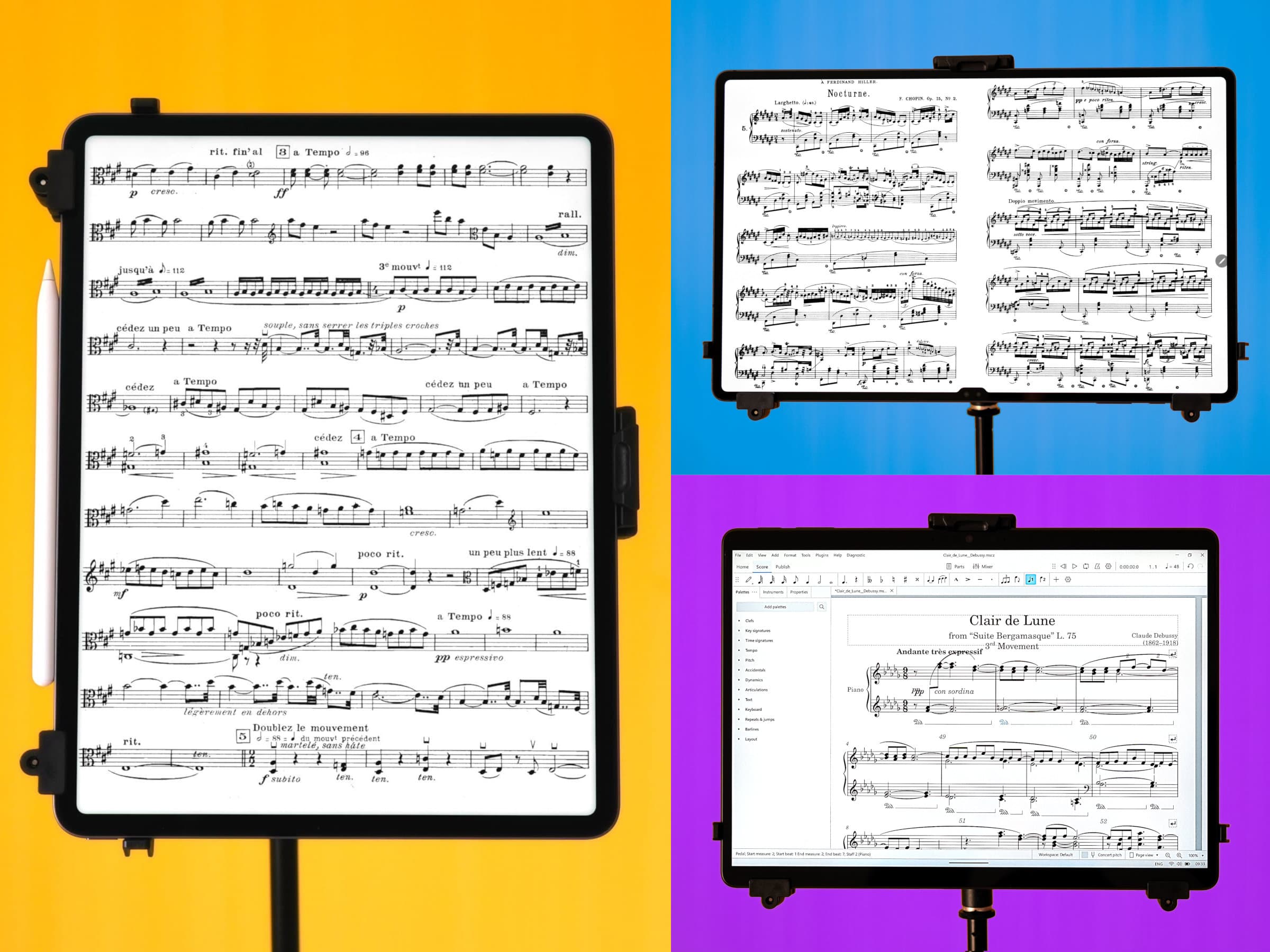
Sheet music on an iPad (left), a Samsung tablet (top) and a Microsoft 2-in-1 (bottom). Photo: tablets-for-musicians.com
The best tablets for musicians
Last updated on May 22, 2025
As a musician, choosing a tablet is not an easy task. It is an important decision and the tablet will hopefully last for many years. Apple iPads are dominant among professional musicians, but there are a lot of other options out there, so it can be overwhelming to find the right one.
From 2015 to 2021, Apple was the only brand capable of making a tablet large enough to comfortably read sheet music. In 2022, Samsung released its first large tablet, followed by Lenovo in 2023. Large-screen tablets finally became affordable in 2024, with many small tablet manufacturers releasing large Android tablets.
On the Windows side, Microsoft, Asus, and Dell (among others) release 2-in-1 devices that can be used as tablets or laptops. These devices are the best option for running music notation and music production software in addition to reading sheet music.
All these options make choosing a tablet for reading sheet music, recording, and performing more complex than ever, and I really hope this page will help you.
I am registered with the Amazon Associates Program. This website contains Amazon affiliate links (marked with a star). If you click on one of these links and make a purchase, I may receive a commission from Amazon.
I am also enrolled in the Samsung Affiliate Program.
Clicking on an affiliate link does not change the price you pay, and will help me continue to test tablets and e-readers. Thank you for your trust and support!
 I am a classical musician (violist) with 20 years of professional experience in orchestra and chamber music. For many years, I have been advising colleagues, students, and fellow musicians in the choice of their tablet.
I am a classical musician (violist) with 20 years of professional experience in orchestra and chamber music. For many years, I have been advising colleagues, students, and fellow musicians in the choice of their tablet.
Along with the many positives of using tablets / iPads, I’ve also seen the negatives: tablets crashing just before going on stage, batteries that don’t hold up during long rehearsal days, and missing page turner pedals in concert.
I spent my school years in France, and this article must be riddled with spelling and grammar mistakes, for which I apologize. Feel free to send me any corrections!
There is no test protocol! I use the most different tablets and iPads possible in my real life as a musician, which includes practicing, rehearsing and playing concerts.
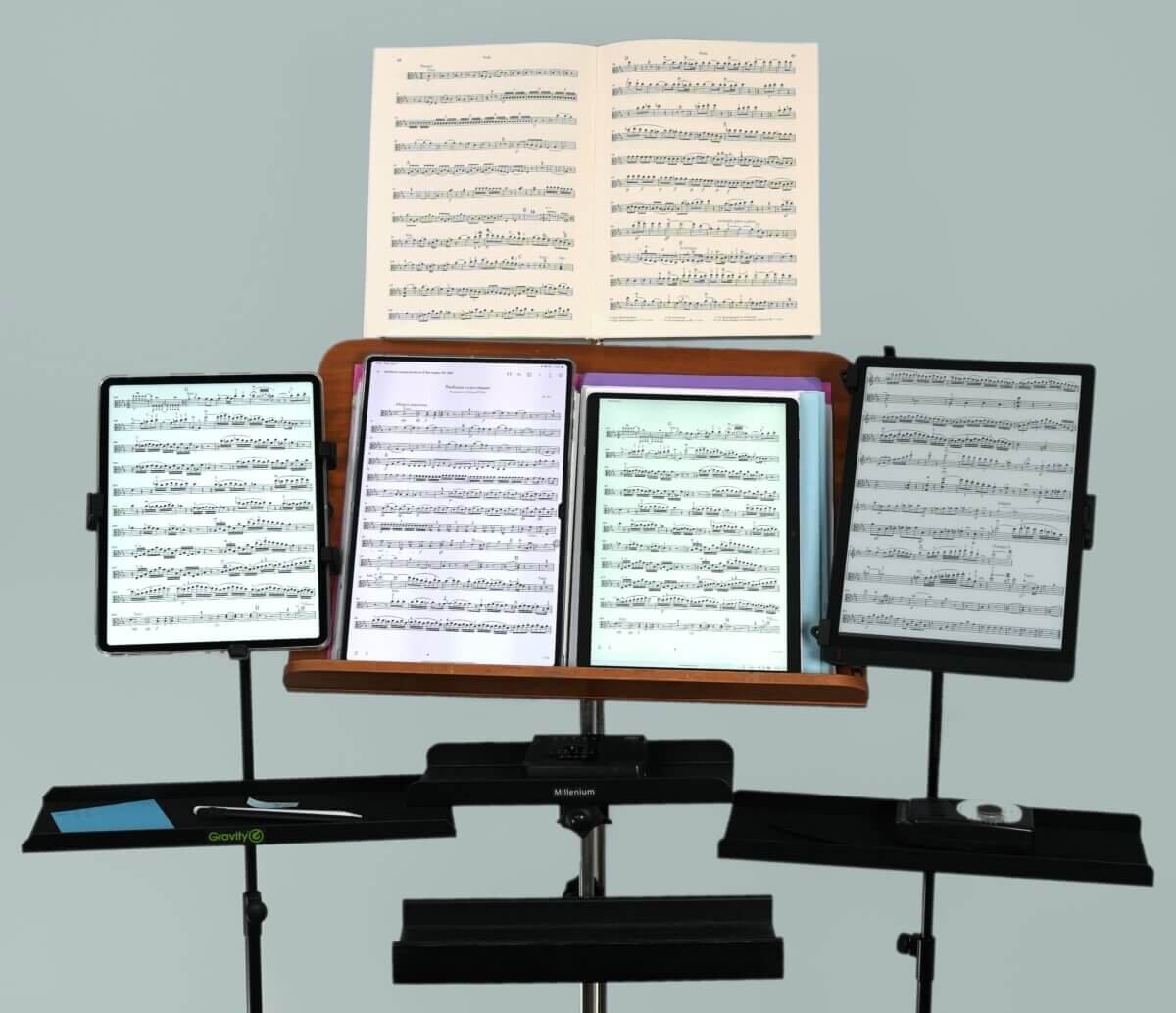
Practicing with multiple tablets at the same time can be laborious. Photo: tablets-for-musicians.com
The tablets (and e-readers) are purchased with my own funds and used as long as I please. This means that my tablet / iPad reviews are always independent, long term and real life reviews.
1. Apple iPad
The iPad Pro is undoubtedly the tablet most used by professional musicians. Paired with forScore (one of the best sheet music app), the large iPad Pro 13 is the absolute reference for reading sheet music.
For a majority of professional and amateur musicians, the 13-inch iPad Pro is simply the best choice, if your budget is up to it. If you want to spend less, the 13-inch iPad Air is also an excellent choice.
For an even lower budget, the older 5th (2021) and 6th (2022) generation 12.9-inch iPad Pros are still fantastic, and are widely available on the second-hand market.
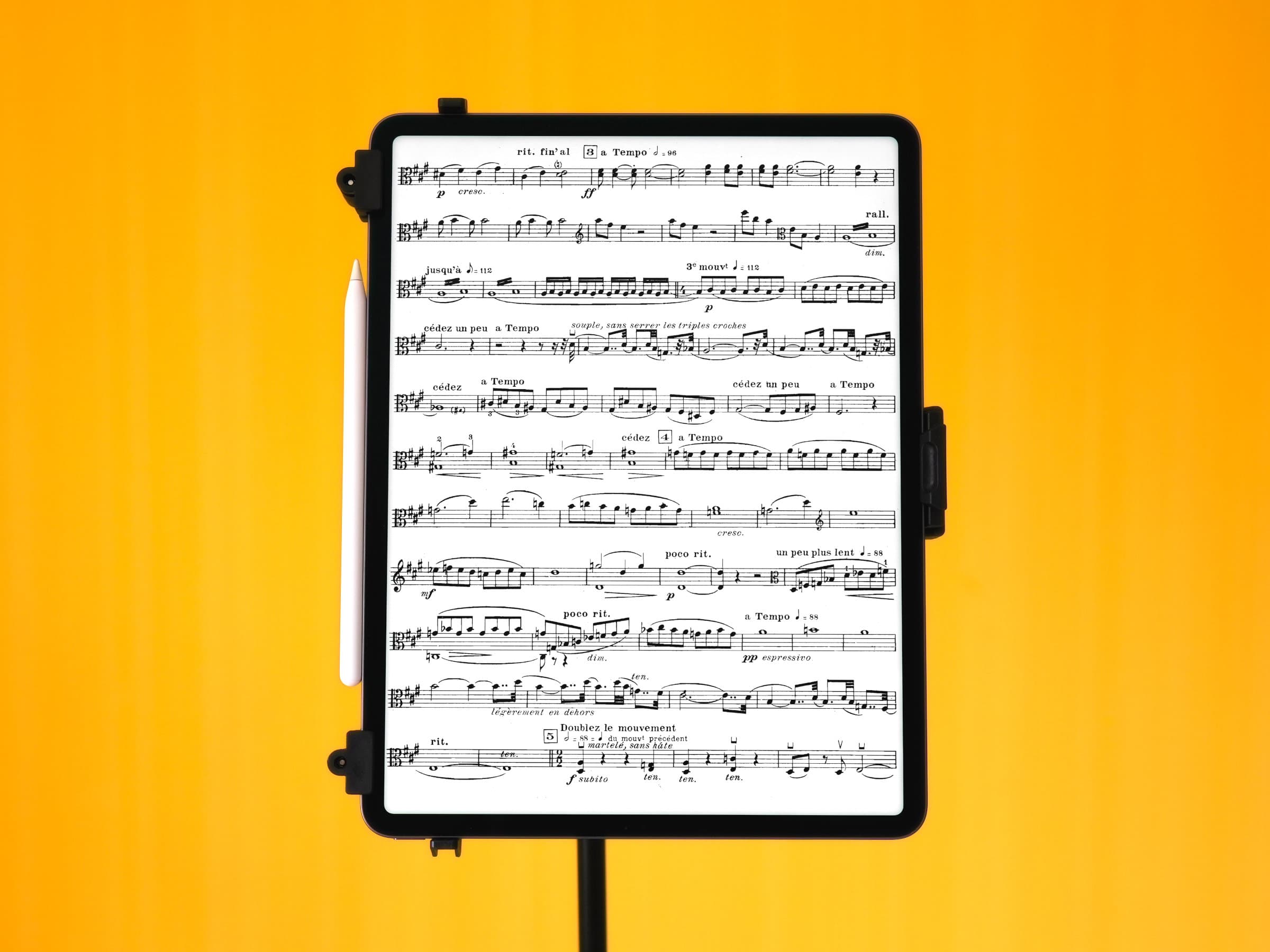
Sheet music on the 12.9-inch iPad Pro. Photo: tablets-for-musicians.com
Which iPad model is best for reading sheet music?
The 13-inch iPad Pro (2024) is definitely Apple’s best tablet for reading music. Its screen is slightly smaller than a sheet of paper.
To be precise, the area of the displays of the 13-inch iPad Pro (and Air) is:
- 83.9% of the area of a sheet of A4 paper or
- 86.8% of the area of a sheet of Letter paper.
Its aspect ratio is closer to Letter format than A4:
- iPad 12.9 and 13-inch: 1.33 (4:3) aspect ratio
- Letter: 1.29 (22:17) aspect ratio
- A4: 1.4 (7:5) aspect ratio
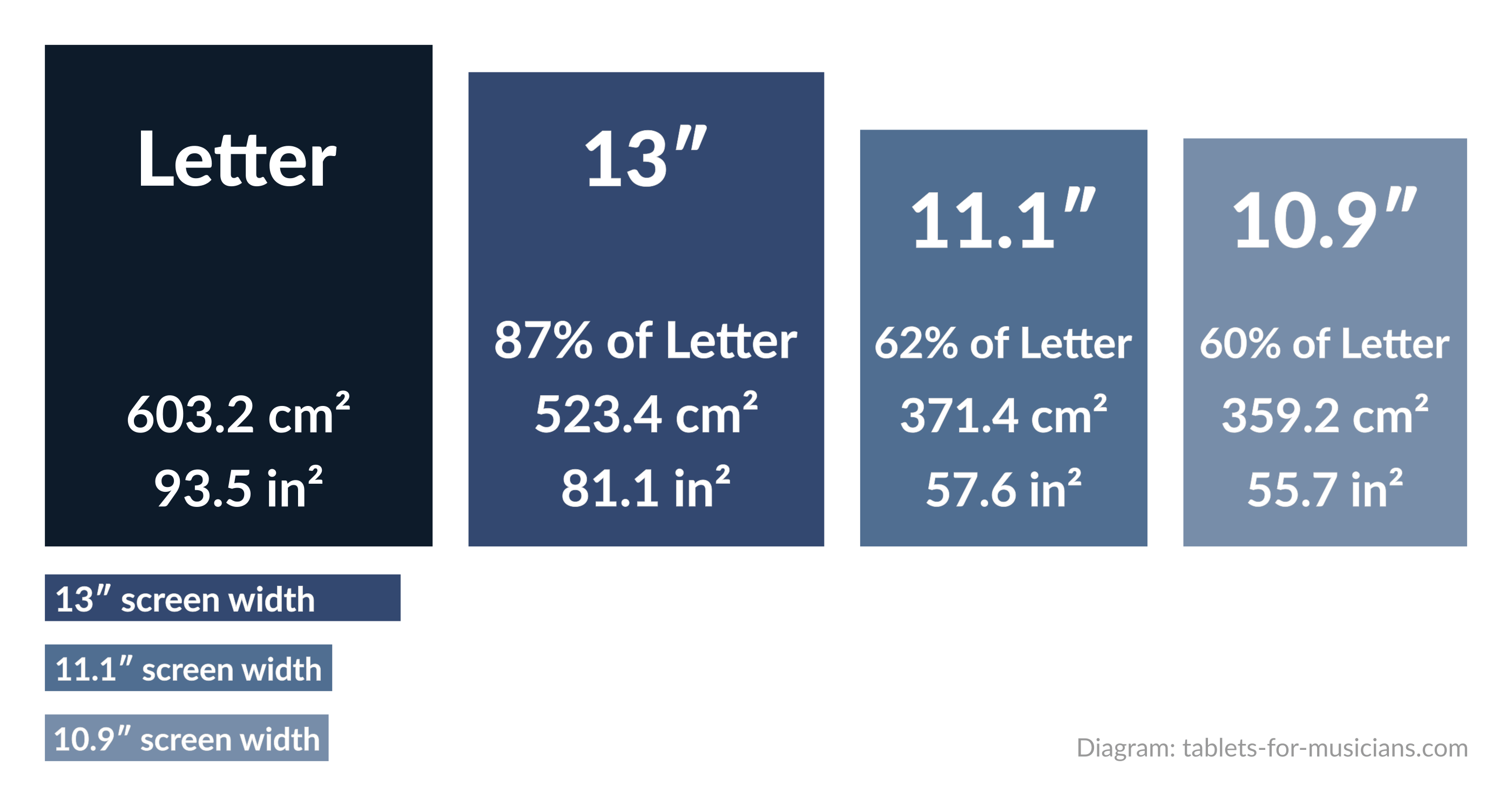
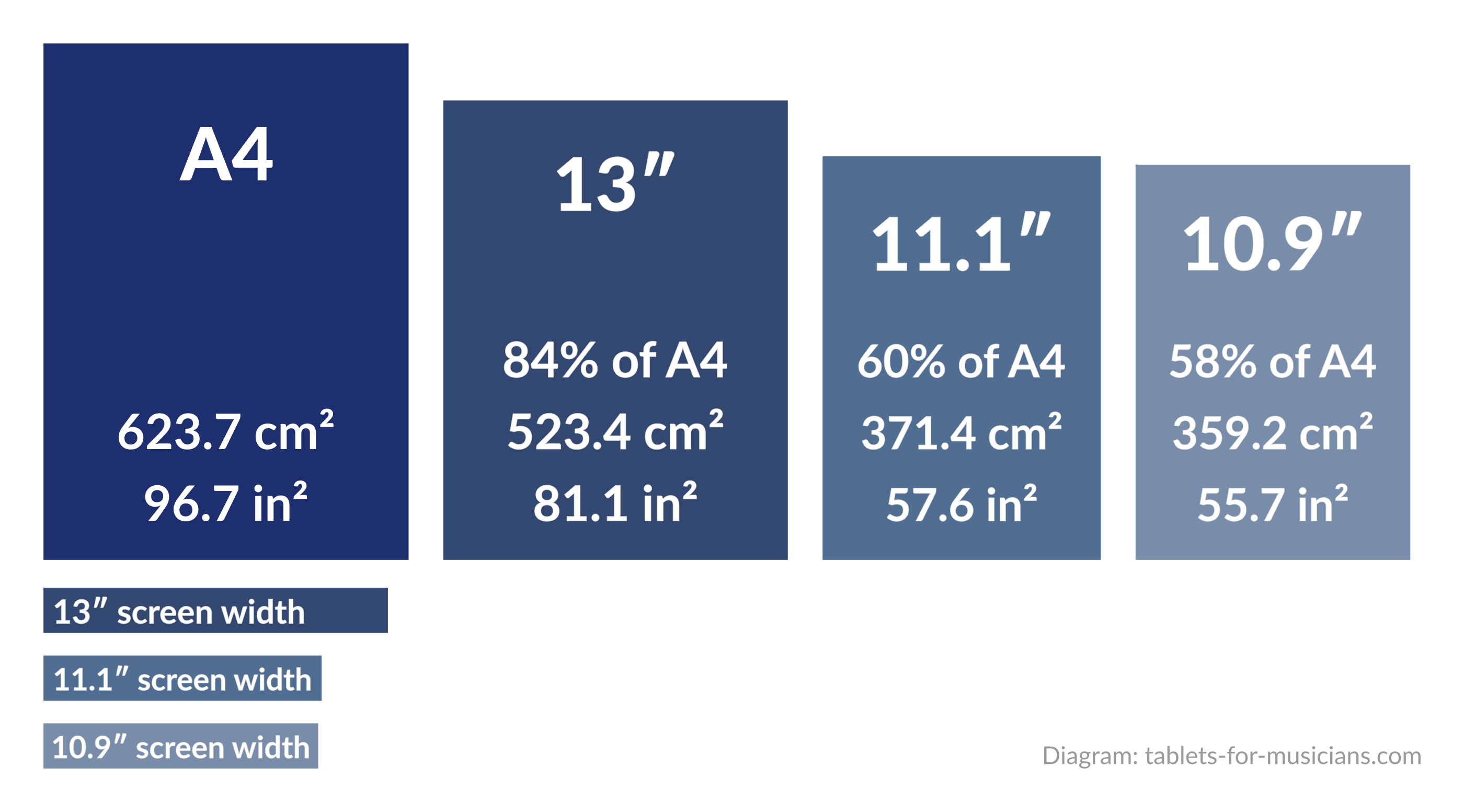
A4 and Letter paper sizes compared to 13-inch and 11-inch iPad Pro screens. The surfaces and dimensions are those of the screens and not those of the tablets.
The screen size of the 13-inch iPad models (and of the older 12.9-inch models) is sufficient to display complex scores. By cropping the score margins (which is very easy in sheet music reading apps such as forScore, Newzik or MobileSheets), you can get close to the size of a printed score.
The 13-inch iPad Pro and Air are sleek and look great on stage. They fit on any “normal” sheet music stand or on dedicated tablet stands.
11‑inch iPad Pro and iPad Air, “standard” iPad
The iPad Pro 11 and iPad Air 11, on the other hand, are too small to read music parts or scores without straining your eyes. The screen of the 11-inch iPad Pro is only 61.6% of the area of a sheet of Letter paper (or 59.6% of the A4 paper format).
The 11-inch iPad models are therefore more suitable for displaying tablatures, chords, or lyrics (e.g., with SongSheet Pro or Ultimate Guitar). They blend in very well on stage, especially on a tablet stand.
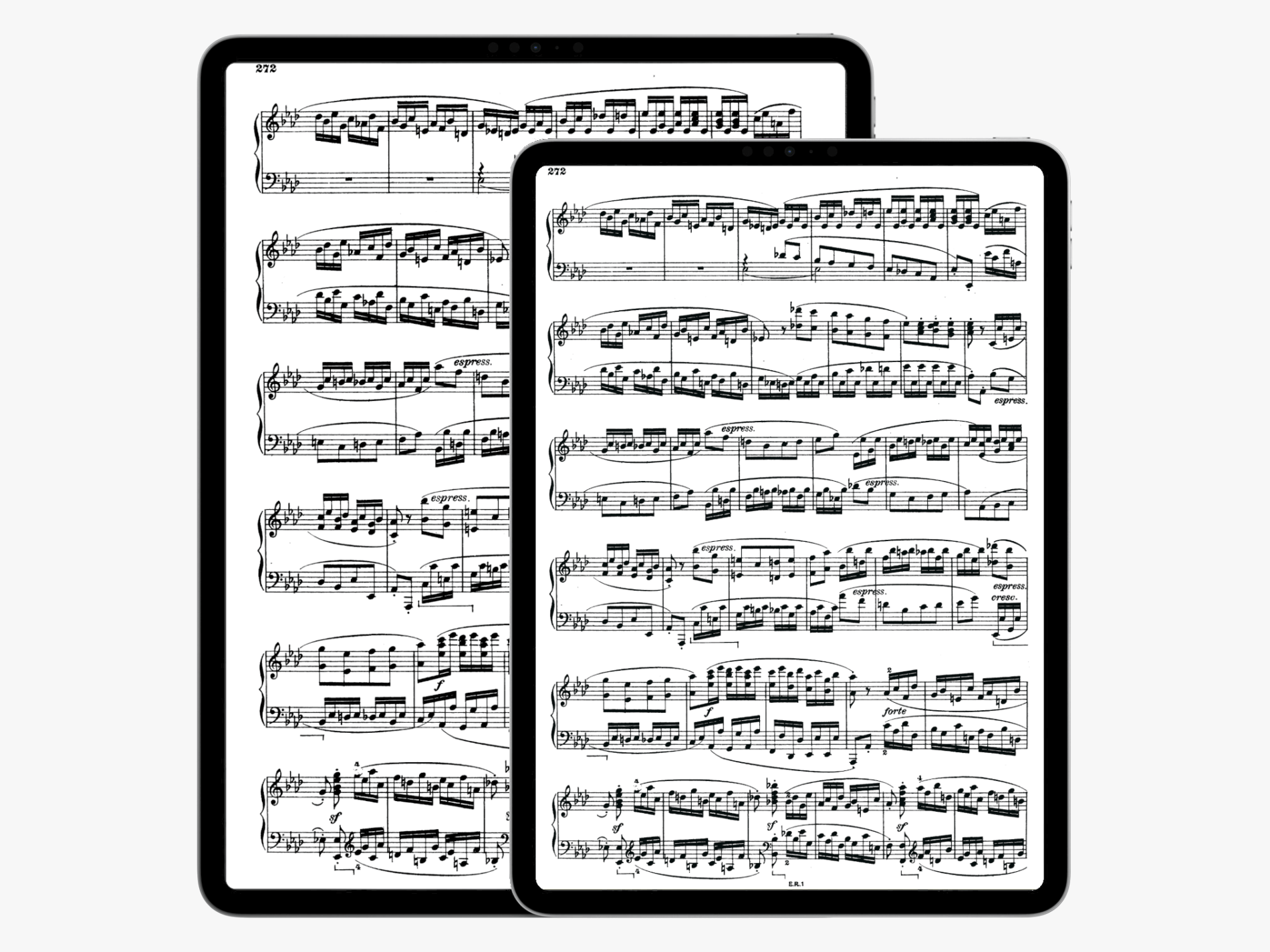
The display of the 11-inch iPad Pro represents only 71% of the area of its 13-inch big brother. Here they are compared in Beethoven’s Piano Sonata № 12 in A-flat major (Opus 27).
The same goes for the iPad Air and the 10th and 11th generation “normal” iPads (2022 and 2025). They feature a 10.86-inch panel that is only slightly smaller than the one on the 11-inch iPad Pro. The display is too small to avoid squinting your eyes during long rehearsals or performances.
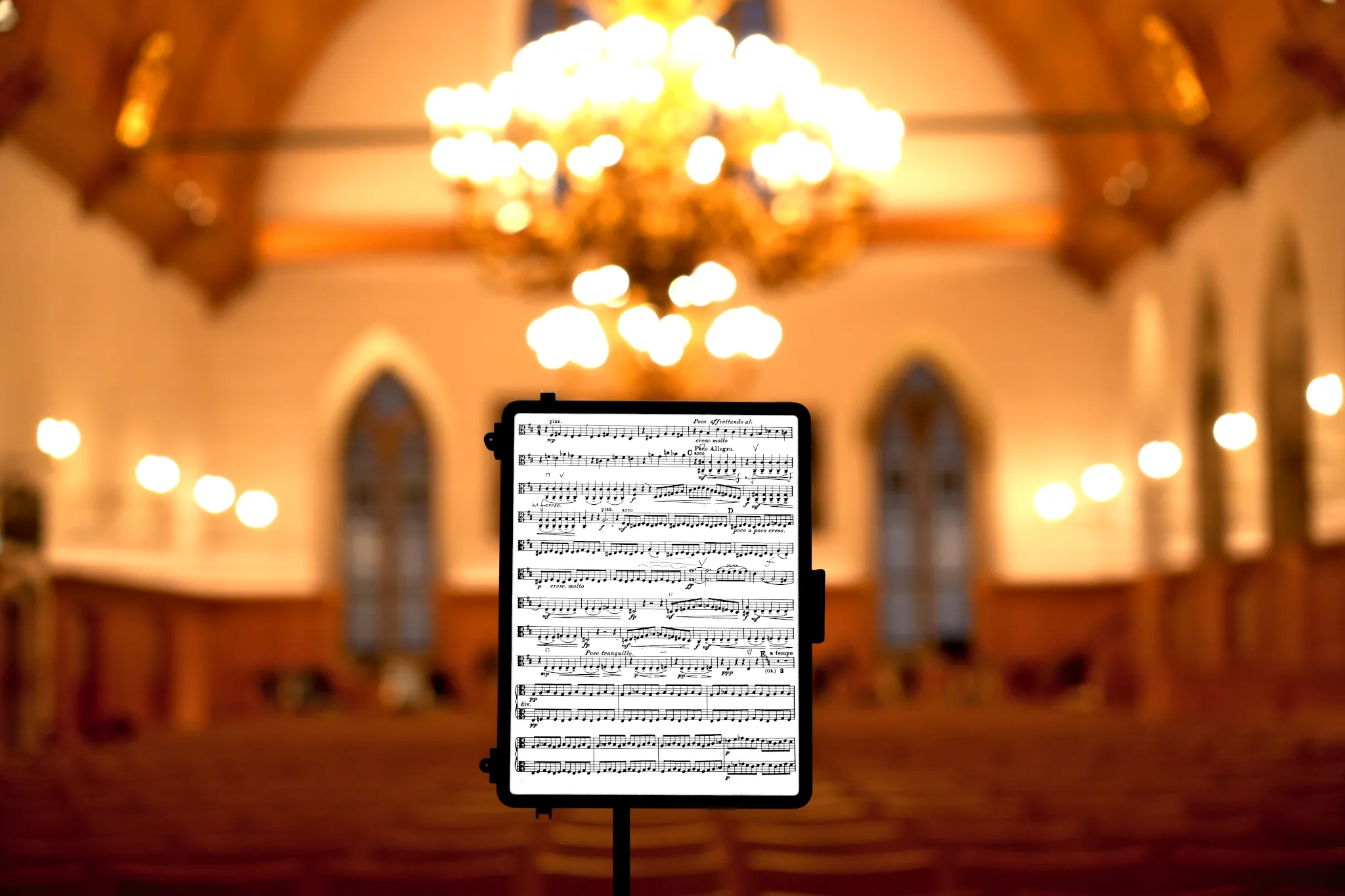
A little practice on my iPad before a baroque music concert. Photo: tablets-for-musicians.com
Sheet music on the iPad: what are the cons?
Besides a very high price, Apple iPads have a number of disadvantages that can lead to the choice of another tablet or e-reader:
- The 4:3 aspect ratio of Apple iPads is not ideal for displaying sheet music: the screen is not tall enough, and the toolbars tend to overlap the music. When used in landscape mode, a particularly large amount of space is lost, as can be seen in the screenshot below. Musicians who often play in landscape mode (pianists?) should take a look at Samsung’s Galaxy Tab Ultra. The latter has a 16:10 aspect ratio, in which virtually no space is wasted in landscape mode.
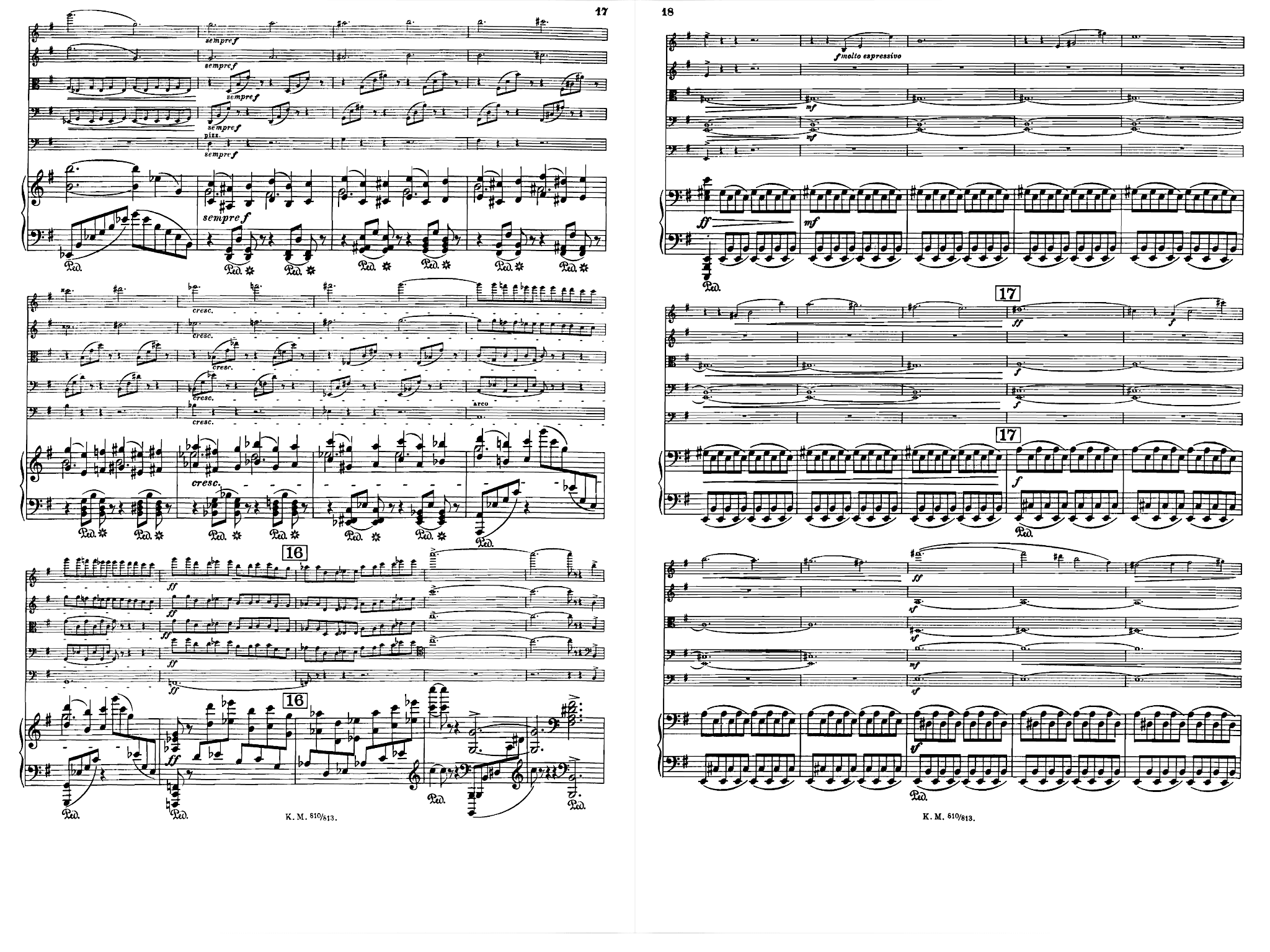
Piano sheet music on iPad: Due to the 4:3 aspect ratio of the display, screen space is lost when used in landscape mode (bottom of the image).
- Transferring data (for example, sheet music in PDF format) from a PC or Android mobile phone can be tricky, and you won’t find an SD or microSD card slot.
- Apple’s vendor lock-in is stronger than on other platforms. For example, the score-reading apps forScore, Newzik and Enote are only available on Apple devices.
Professional musicians and music students: In which cases is there no alternative to Apple?
It is difficult to do without Apple iPads in the following cases:
- You want or need to use forScore. ForScore is often considered as the ultimate sheet music reading app and is only available for iPad and iPhone.
- Your friends/colleagues use AirDrop to transfer music files (for example, PDF sheet music). AirDrop only works with Apple devices.
- Some of the music apps that you want to use are only available on the Apple Store, like Newzik, Enote, GarageBand or KORG Gadget 2.
- You need a powerful tablet to edit videos with, for example, DaVinci Resolve (not available on Android tablets).
However, if you mainly want to use a tablet as a sheet music reader to practice, rehearse and play gigs (and if your budget is tight), Android (or Windows) tablets can be good alternatives to Apple iPads.
Pros
- The iPad Pro is the de facto standard for music
- AirDrop, forScore, Newzik, GarageBand, …
- Unmatched performance
- Holds value over time, long-term support
- Excellent accessories (Apple Pencil, Magic Keyboard)
Cons
- Glossy display
- 4:3 aspect ratio, not ideal for sheet music
- No SD or microSD card slot
- Slow charging
- Extremely expensive
iPads for musicians: Verdict
You can’t go wrong with a 12.9-inch or 13-inch iPad. The iPad Pro in particular is the most used tablet among professional musicians and has the best stylus and keyboard. iPadOS still has some exclusive apps (forScore, Newzik, GarageBand) and features (AirDrop, AirPlay), as well as the best performance of any tablet to the day.
Apple iPads in general have some drawbacks though, the biggest being their aspect ratio, which is ideal for office use, but not for displaying sheet music. Also, don’t expect a fast battery charge during rehearsal breaks, as the iPad Pro has the slowest charging speed of all the tablets in its category.
In my opinion, the 11-inch iPad models (Pro and Air) and the “standard” iPad are too small for more than casual music practice. If you’re on a budget, I would strongly recommend getting a used or refurbished 12.9-inch iPad Pro over one of the smaller models.
If you already have an iPhone or a Mac and your budget allows, it’s a no-brainer: the 13-inch iPad Pro is your best option, followed by the 6th and 5th generation iPad Pros and the iPad Air 13. However, if you’re not tied to the Apple ecosystem, a Samsung Galaxy Tab s9 or S10 Ultra may also be an excellent choice.
No longer available from Apple.
Learn more about iPads for reading sheet music!
If you are primarily interested in Apple iPads, you will find information on each model, comparisons of the different screen sizes and much more in the following article:
What are the alternatives to Apple iPads for reading sheet music?
There are excellent alternatives to Apple iPads for reading and editing sheet music. The following tablets are in a similar price and performance category to Apple’s iPad Pro and are discussed later in this article:
- The Samsung Galaxy Tab S10 Ultra, a huge tablet with a 14.6-inch screen, ideal in landscape mode. It is the favorite tablet of the author of these lines, a professional musician.
- Its Lenovo counterpart, the “Tab Extreme”, which was launched in June 2023.
- Microsoft’s Surface Pro 11, featuring a display with an aspect ratio of 3:2, which is ideal for displaying parts or scores.
Large e-book-readers (with e-ink) can also be an alternative to iPads or tablets. There are only three models large enough to read music:
- The BOOX Tab X, with a 13.3-inch e-paper screen (released in January 2023).
- Its twin brother, the PadMu 4, which has an additional software layer for musicians.
- The BOOX Note Max, with an upgraded e-paper display but no backlight (released in January 2025)
You can find more information about these solutions in my comparison of e-readers for musicians.
2. Android tablets
Samsung Galaxy Tab S9 / S10 Ultra
The Samsung Galaxy Tab S9 Ultra (released in August 2023) and its successor, the S10 Ultra (released in October 2024), are high-end Android tablets with 14.6-inch displays. They are the largest tablets from a major brand available on the market in 2025.
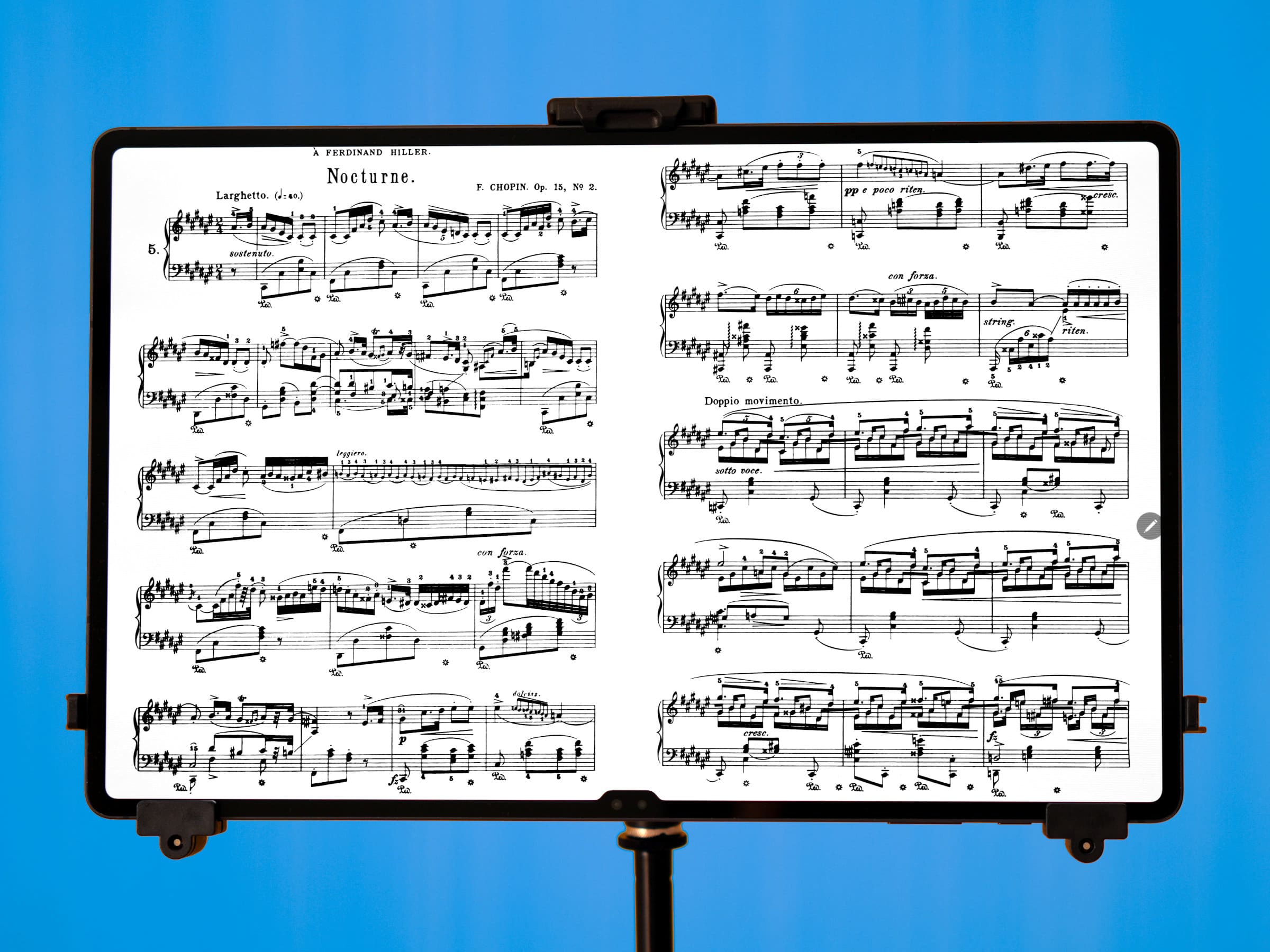
Frédéric Chopin’s Nocturne Opus 15 № 2 on a Samsung Galaxy Tab S9 Ultra in landscape mode. Photo: tablets-for-musicians.com.
At 1.61 pounds (732 grams), the Tab S9 Ultra is relatively light considering its huge screen size. The S10 Ultra is even lighter at just 1.58 pounds (718 grams).
The display size corresponds to 102% of the area of a Letter-size paper or 99% of the area of an A4 sheet of paper. This makes the S9 and S10 Ultra the closest you can get to printed music in terms of display size. However, it is still significantly smaller than commonly used orchestral sheet music and scores.
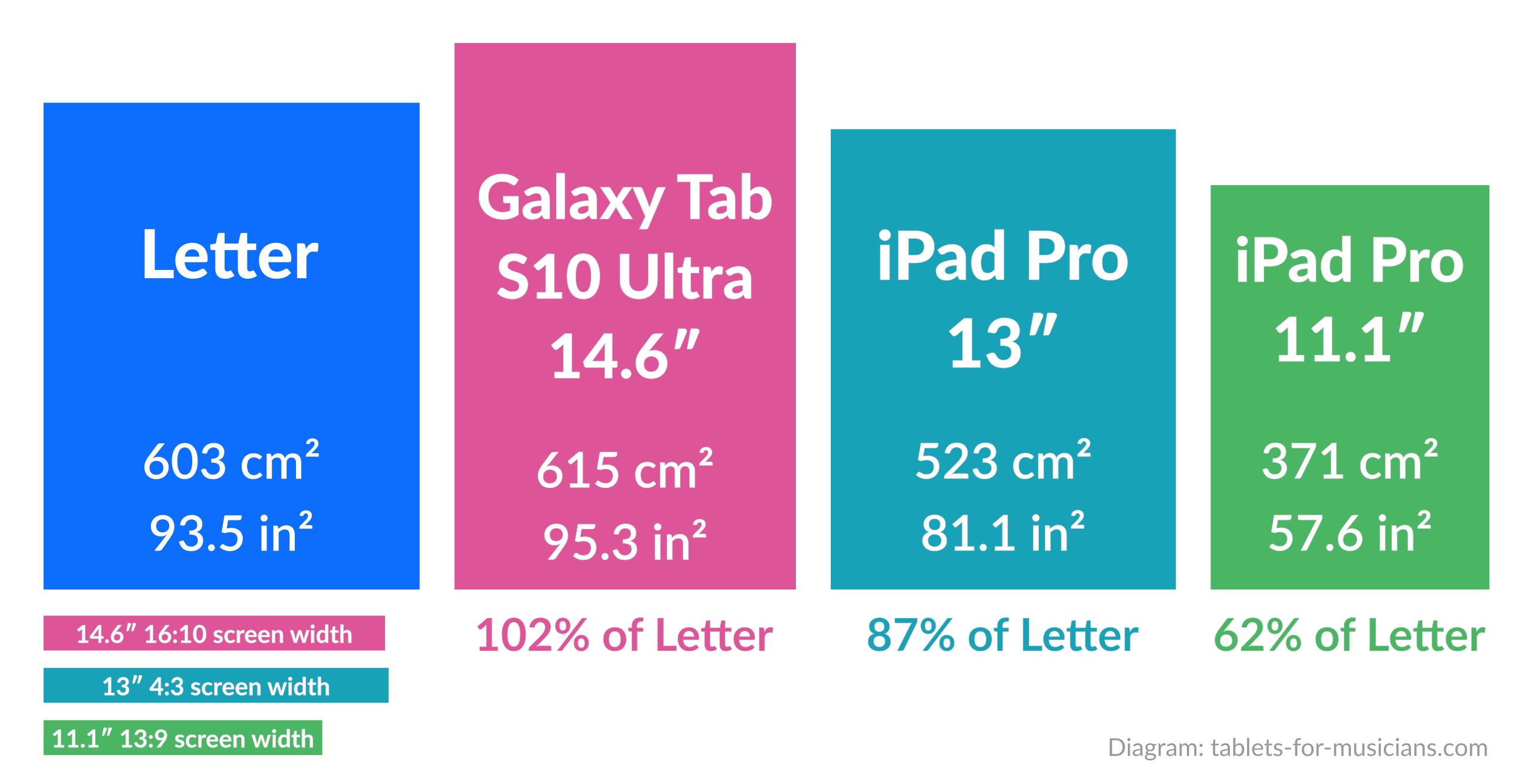
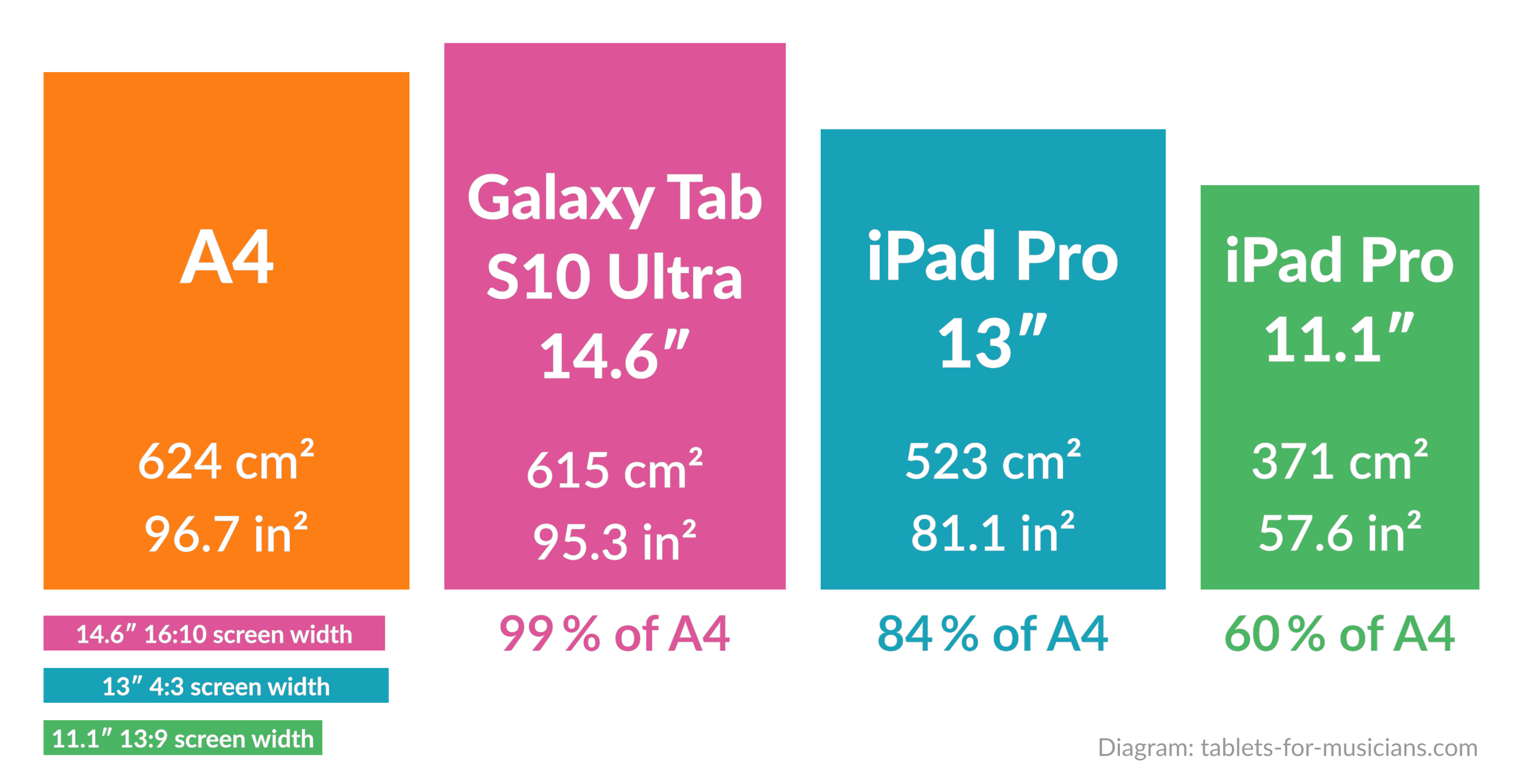
The largest tablet on the market, the Samsung Galaxy Tab S10 Ultra, has a display area equivalent to 102% of a sheet of Letter paper (or 99% of the A4 format). The surfaces and dimensions are those of the screens and not of the tablets.
The display of the Samsung tablet is very elongated, the aspect ratio is 16:10, which might seem impractical at first glance. However, this unusual format is actually very well-suited for displaying sheet music:
- The toolbars (shown here with MobileSheets) do not cover the score (as is the case with forScore on the iPad):
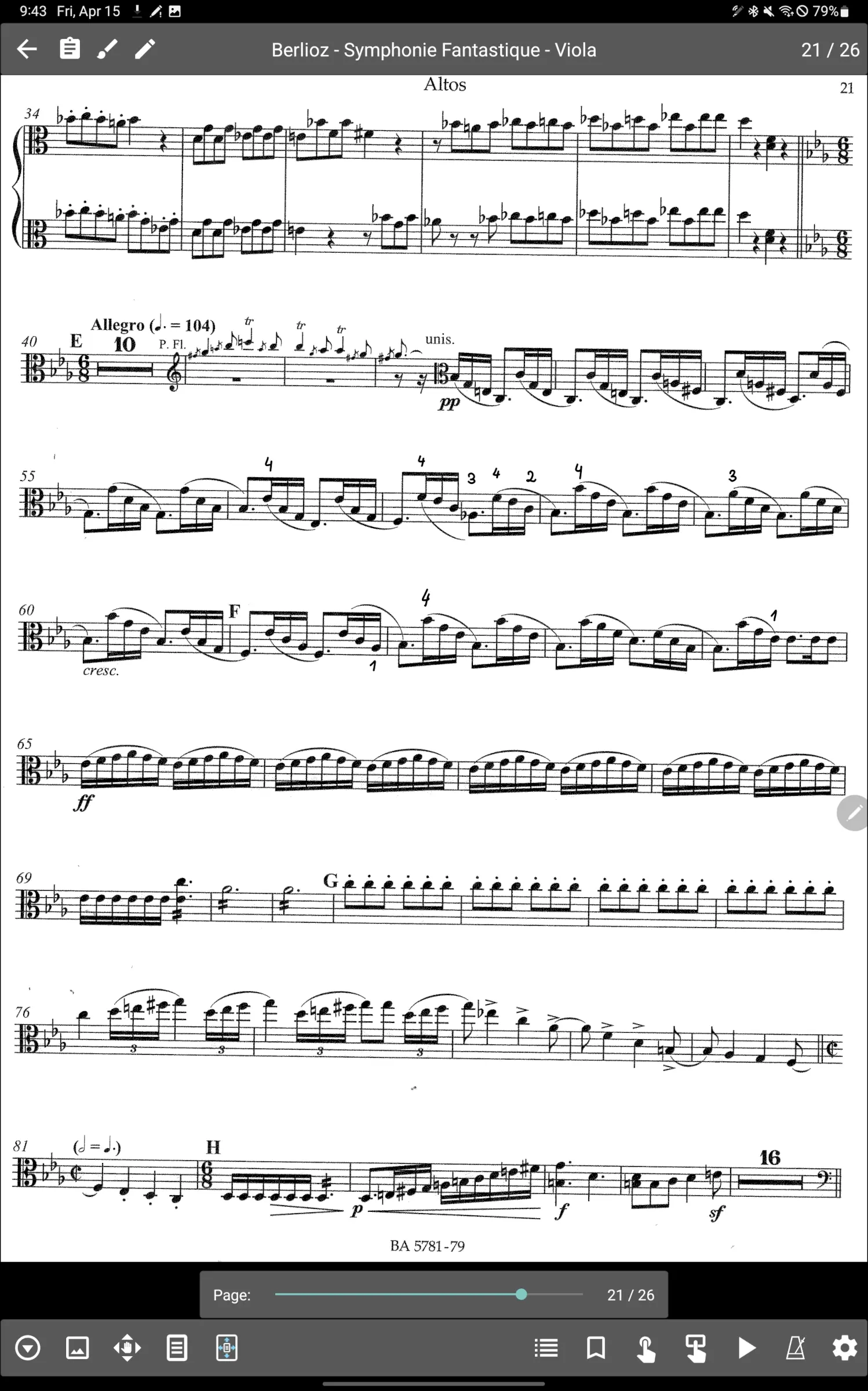
- Working with a split screen works great, for example with YouTube, a score or a tuner in the lower part:
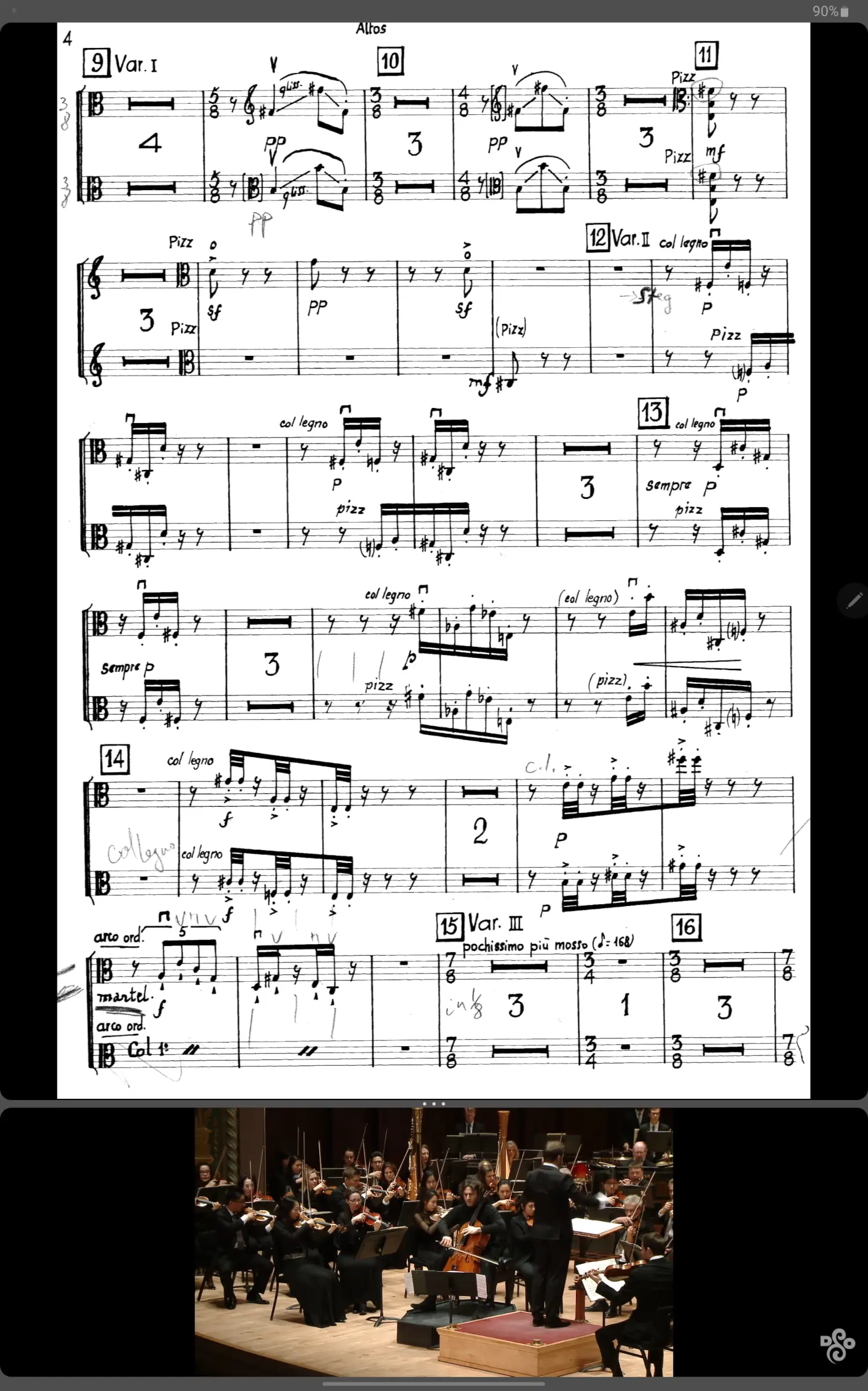
- In landscape mode, the 16:10 aspect ratio is (almost) perfect for displaying two sheets of music side by side:
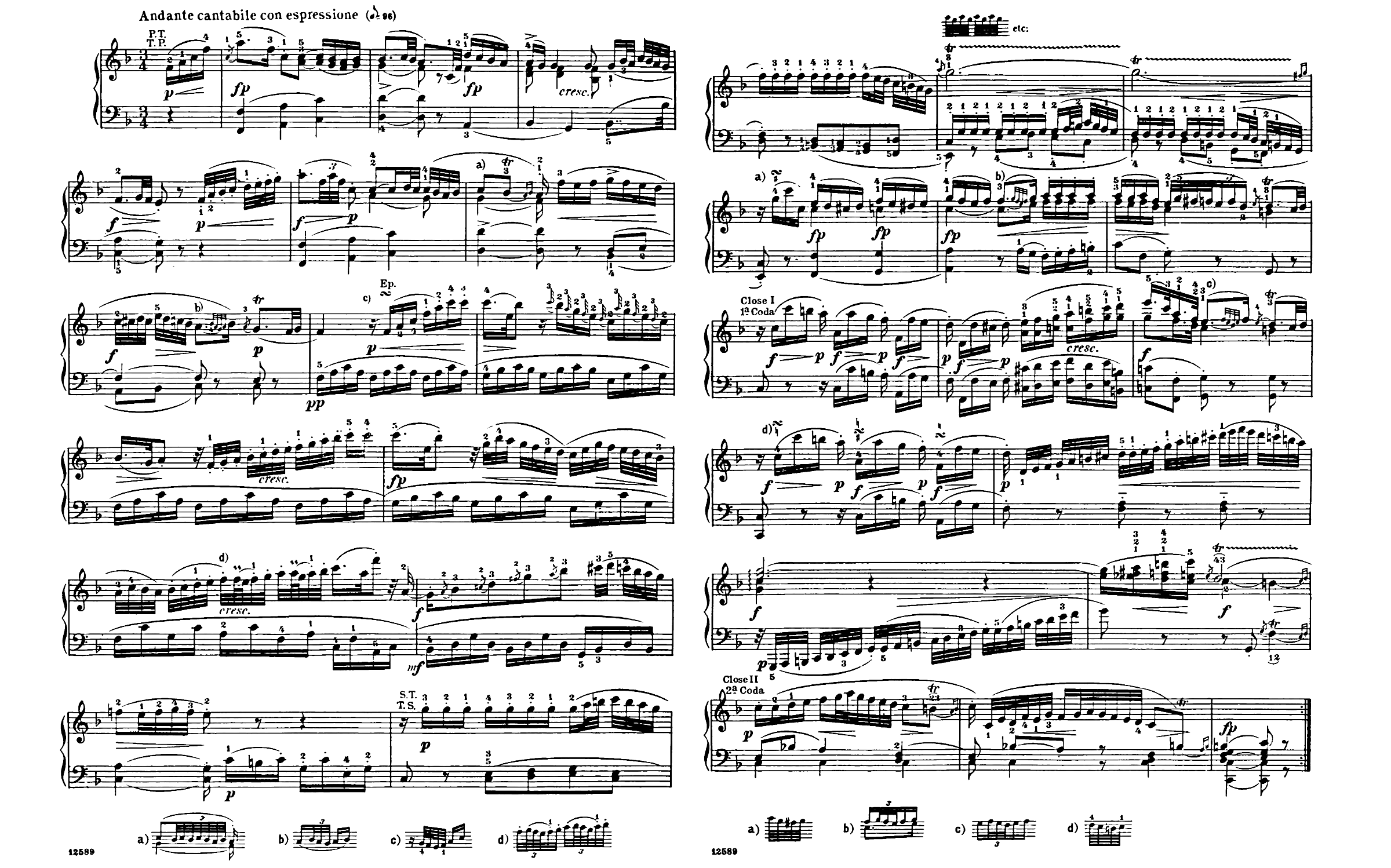
The beginning of the second movement of Mozart’s Piano Sonata № 8 in A minor, K. 310 / 300d on the Samsung Galaxy Tab S9 Ultra (screenshot)
Samsung Galaxy Tab S9 / S10 Ultra: Pros
- Largest display on the market, versatile aspect ratio
- Excellent battery life
- MicroSD card slot
- 5 years (S9 Ultra) or 7 years (S10 Ultra) of security updates
- Superfast charging (up to 45W)
Cons
- Glossy display (prone to reflections)
- Some apps (like forScore) are not available for Android
- Stylus (“S-Pen”) less pleasant to use than the Apple Pencil
- Very expensive
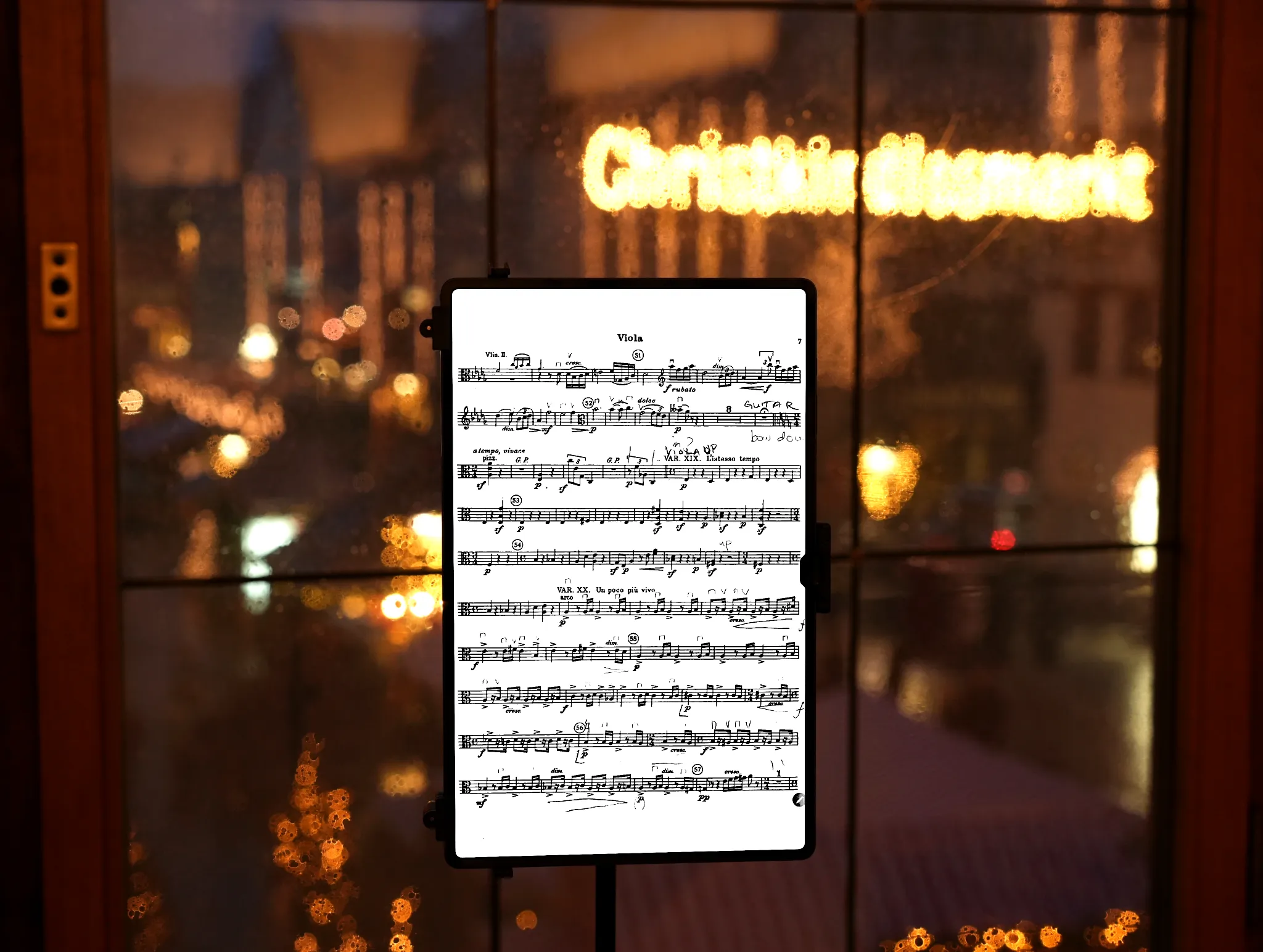
The Samsung Galaxy Tab S10 Ultra is the best Android tablet for reading sheet music. Photo: tablets-for-musicians.com.
Music on the Samsung Galaxy Tab S9 / S10 Ultra: Verdict
The Galaxy Tab S9 and S10 Ultra are arguably the best Android tablets for music. They have the largest display available on the tablet market. This gigantic screen, combined with the unique aspect ratio, makes them excellent tablets for reading sheet music.
In real life, the battery life of the Tab S9 and S10 Ultra has proven to be better than the battery life of the 12.9-inch and 13-inch iPad Pro. Thanks to the ultra-fast charging, it is also possible to recharge the battery between rehearsals or even during a rehearsal break (plus 20% every 10 minutes).
Among the downsides is the stylus, which didn’t quite convince me (but is included with the tablet). And of course the very high price, which however remains well below Apple.
I spent two years working with the Galaxy Tab S8 Ultra and 16 months with the S9 Ultra (alternating with other tablets and e-readers). In total, this meant countless hours of practice and rehearsals and a good number of concerts. I can therefore recommend the Galaxy Tab Ultra series to (almost) all musicians, on an equal footing with the 13-inch iPad Pro.
No longer available from Samsung.
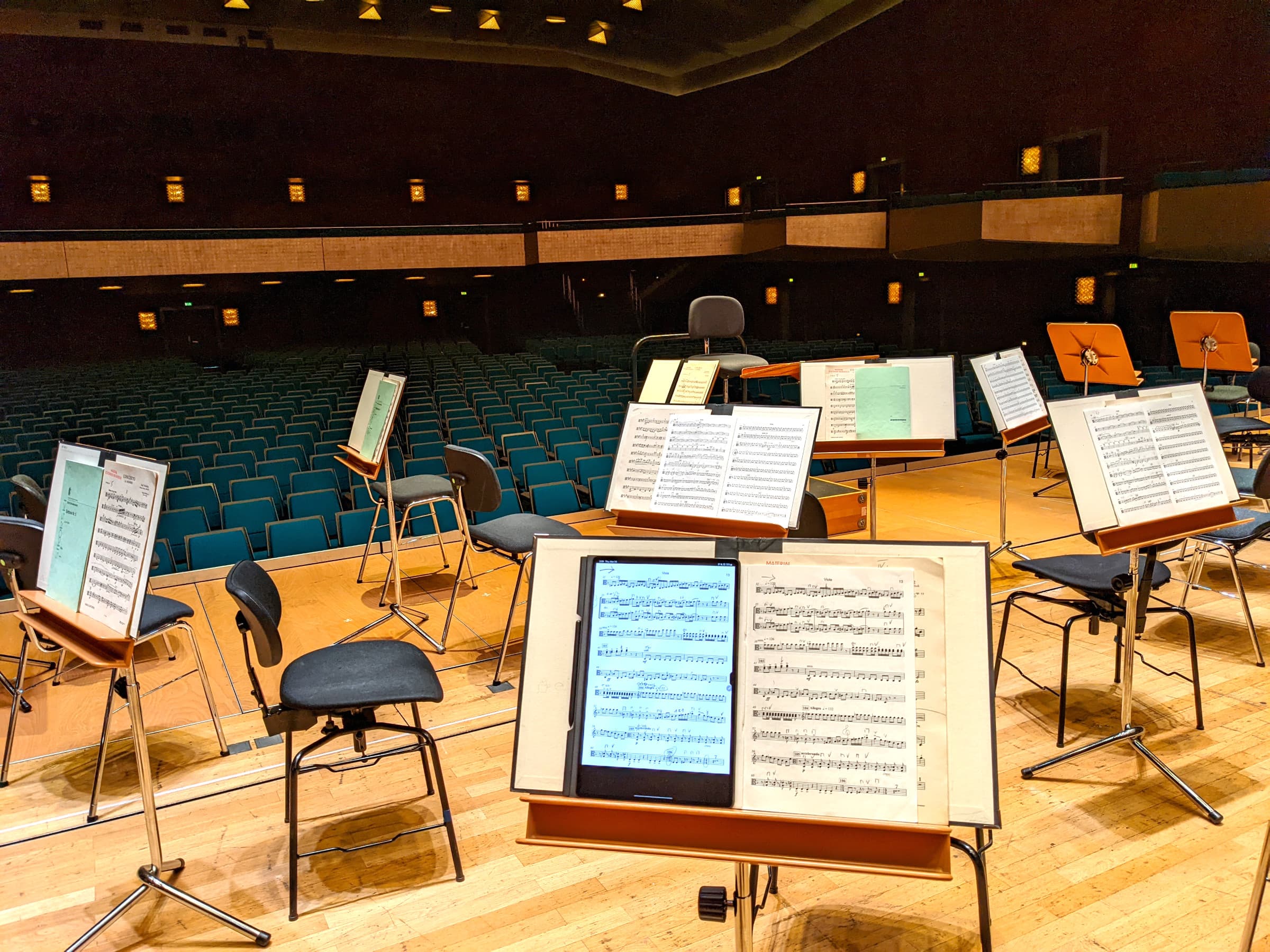
Symphony orchestra rehearsal with the Samsung Galaxy S8 Ultra, seen from the viola section. Photo: tablets-for-musicians.com
Is the previous-generation Samsung Galaxy Tab S8 Ultra still a good choice in 2025?
Absolutely! The Tab S8 Ultra is very similar to the S9 and S10 Ultra, the differences are minimal. For reading sheet music (MobileSheets, MuseScore) or for almost any music app (Simply Piano, Yousician, BandLab…), the S8 Ultra is still a terrific tablet. Nevertheless, there is one important point to keep in mind: Samsung’s security updates policy.
- Samsung offers five years of security updates for both the Tab S8 and S9 tablet series, as well as “up to four generations of One UI and Android OS upgrades”.
- The Tab S10 series will get seven years of updates. This is almost the same level of support as the iPad Pro, and no other Android tablet manufacturer promises this length of security updates, not even Google.
What’s essential here is that this rule applies from the product’s global launch date – not from the date of purchase. With this information, it is easy to determine how long the S8, S9 and S10 tablet series will be supported.
How long will the Samsung Galaxy Tab S8, S9 and S10 series receive software updates?
- The Galaxy Tab S8+ and S8 Ultra were released in April 2022 and came with Android 12 and Samsung’s own One UI 4.1 user interface. They will receive security updates at least until March 2027, and be upgraded to Android 16 and One UI 8.
- The Galaxy Tab S9+ and S9 Ultra launched in August 2023, running Android 13 and One UI 5.1. They will receive security updates almost a year and a half longer than the previous generation, at least until July 2028, and will be updated to Android 17 and One UI 9.
- The Galaxy Tab S10+ and S10 Ultra were released in October 2024, they originally came with Android 14 and One UI 6.1. They will receive security updates until October 2031, three years longer than the Tab S9 series! However, Samsung has not published any reliable information about how many major Android and One UI upgrades the Tab S10 series will receive.
Apart from the significantly shorter software support, nothing speaks against getting a Galaxy Tab S8 Ultra for reading sheet music in 2025. If you find a good deal, go for it!
Samsung Galaxy Tab S10 FE+: a smaller, more affordable alternative
Despite its questionable name, the Samsung Galaxy Tab S10 FE+, released in April 2025, is an interesting alternative to the more expensive Tab Ultra. When stacked up against Apple iPads, the Galaxy Tab S10 FE+ competes with the 13-inch iPad Air.
Display
The Galaxy Tab S10 FE Plus has a 13.1-inch display with a 16:10 aspect ratio, which is 82.5% the size of a US Letter sheet of paper (or 78.8 % of the international A4 paper size). Despite its longer diagonal, the Samsung’s display area is slightly smaller than the 13-inch iPad Air’s.
The real difference between the S10 FE+ and the iPad Air is their aspect ratio. Put simply, the iPad display (4:3) is better suited for office work, while the Samsung tablet (16:10) is better for watching movies. Neither is optimal for sheet music: on the iPad, you’ll miss height, and the toolbars will sometimes cover the top staff. On the Samsung, you’ll miss width, which will make your sheet music look smaller.
As a side note, the optimal aspect ratio for displaying sheet music is 3:2. This ratio is found on tablets by Microsoft, Dell, Huawei, TCL, and Oppo/OnePlus.
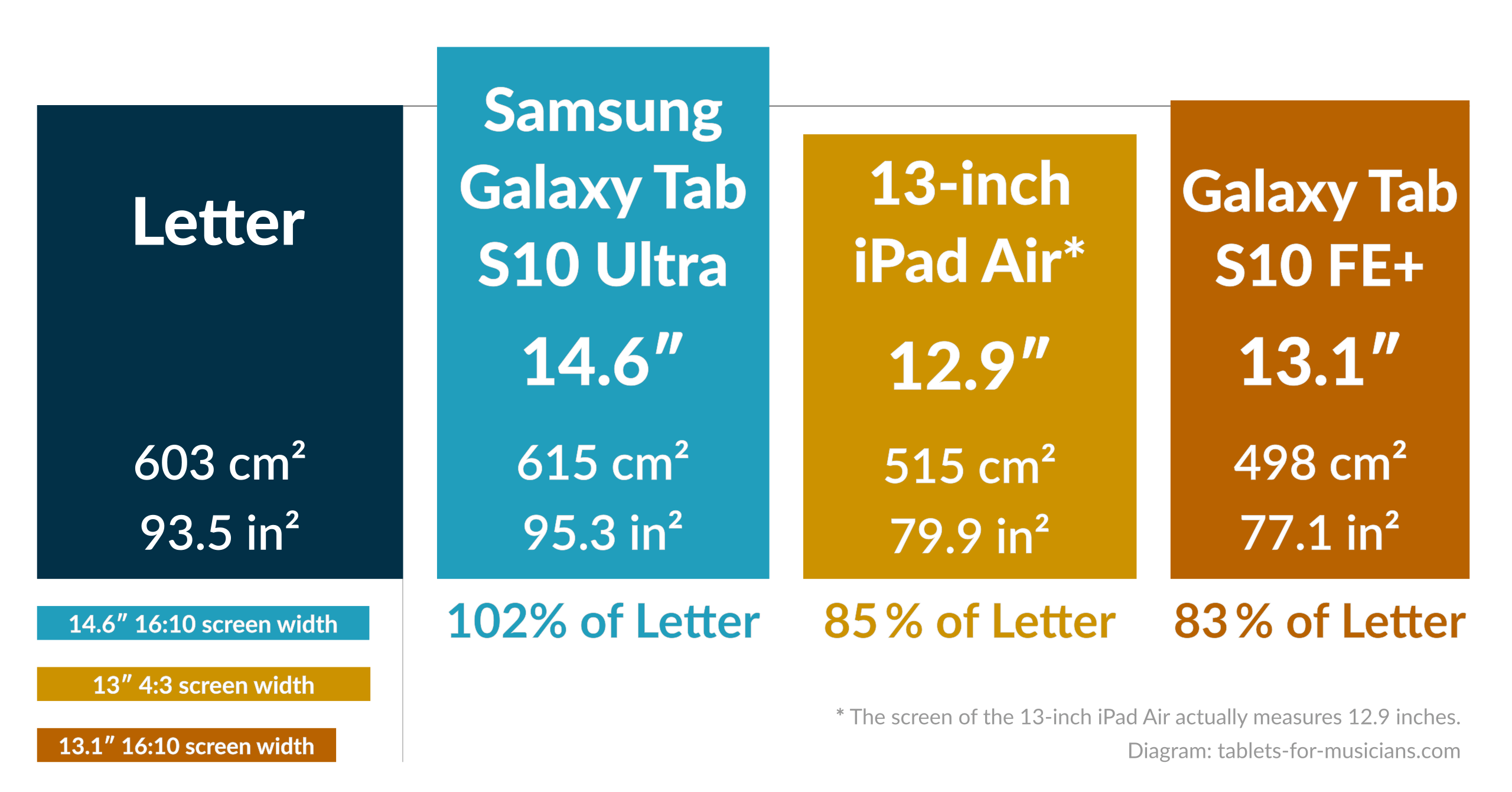
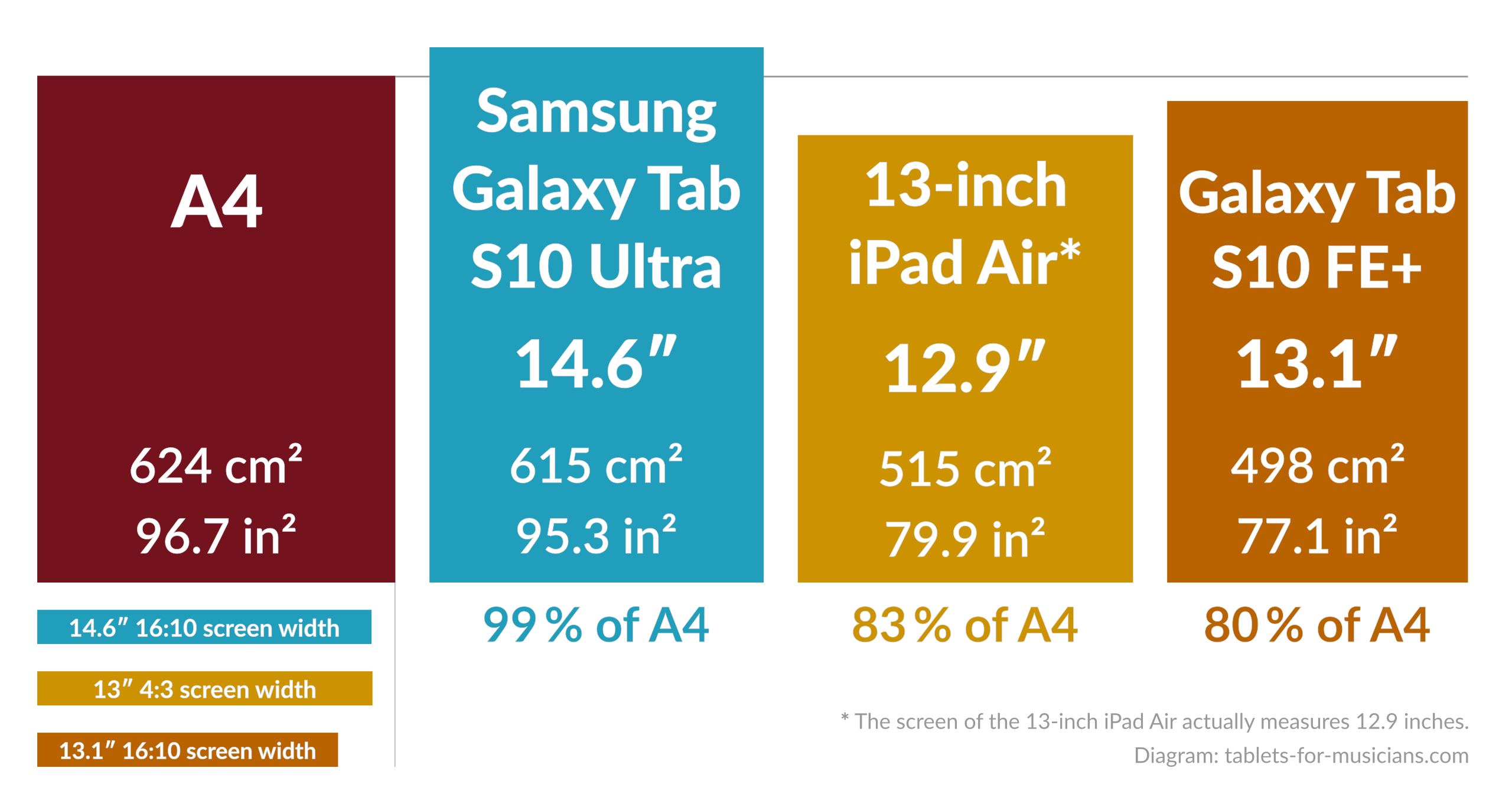
A4 and Letter paper sizes compared to 13-inch and 11-inch iPad Pro screens. The surfaces and dimensions are those of the screens and not those of the tablets.
The screen of the Tab S10 FE+ is relatively bright: it reaches a maximum brightness of 620 nits (cd/m²), which is slightly better than the S10 Ultra (600 nits) and makes it usable outside on bright days. For comparison, the iPad Air has a maximum brightness of 580 nits, and cheap tablets barely reach 400 nits. For musicians who frequently play outside, the 13-inch iPad Pro is the best choice as it reaches 1,010 nits of brightness.
Performance, battery life, and price
In terms of processing power, the Galaxy Tab S10 FE Plus features a mid-range system on a chip (SOC), the Exynos 1580, which can’t compete with the iPad Air’s M3 processor; the latter is about three times faster. However, the S10 FE+ is twice as fast as the Helio G99 or G100 processor found in many cheaper tablets.
The battery life is excellent and should last about 15 hours when reading sheet music. Unfortunately, charging is slow, taking up to three hours for a full charge at a maximum of 25 watts.
What makes the Galaxy Tab S10 FE+ really interesting is its combination of a large screen and a lower price than its main competitor, the 13-inch iPad Air. The price difference becomes even greater when you consider that the stylus is included with the Samsung tablet but not with the iPad.
For about the same price, I would prefer an older (perhaps refurbished) Galaxy Tab S9 Ultra because its screen is much larger. But the S10 FE+ is definitely appealing.
Samsung Galaxy Tab S10 FE+
- Large, bright screen
- Good price-to-display-size ratio
- Stylus included
- Excellent battery life
- 7 years of security updates
Cons
- Smaller than a sheet of paper
- 16:10 aspect ratio
- Mid-range performance
- Charges slowly
The Lenovo Tab P12, an affordable 12.7-inch tablet
I’ve been getting a lot of questions about the Lenovo Tab P12, an Android tablet featuring a 12.7-inch screen with a 16:10 aspect ratio.
This tablet is very attractively priced (less than $400, stylus included), and many fellow musicians seem to be wondering where the differences are compared to the top of the line. Compared to the much more expensive Samsung Galaxy Tab S10 Ultra, for example, the Lenovo Tab P12 has the following weaknesses:
- The size of the display. The 12.7 inches of the Lenovo P12 sound as if the tablet would be comparable to the older 12.9-inch iPad Pro or, for example, the 13-inch iPad Air. In reality, the screen area of the P12 is only 77.7% of the area of a letter-sized sheet of paper. That’s small for reading music. The iPad Air 13 is significantly larger at 85.4% of a sheet of paper. And only the Lenovo Tab Extreme (14.5 inches) and the Galaxy Tab Ultra models are big enough in my opinion: 101.9% of a letter-sized sheet of paper.
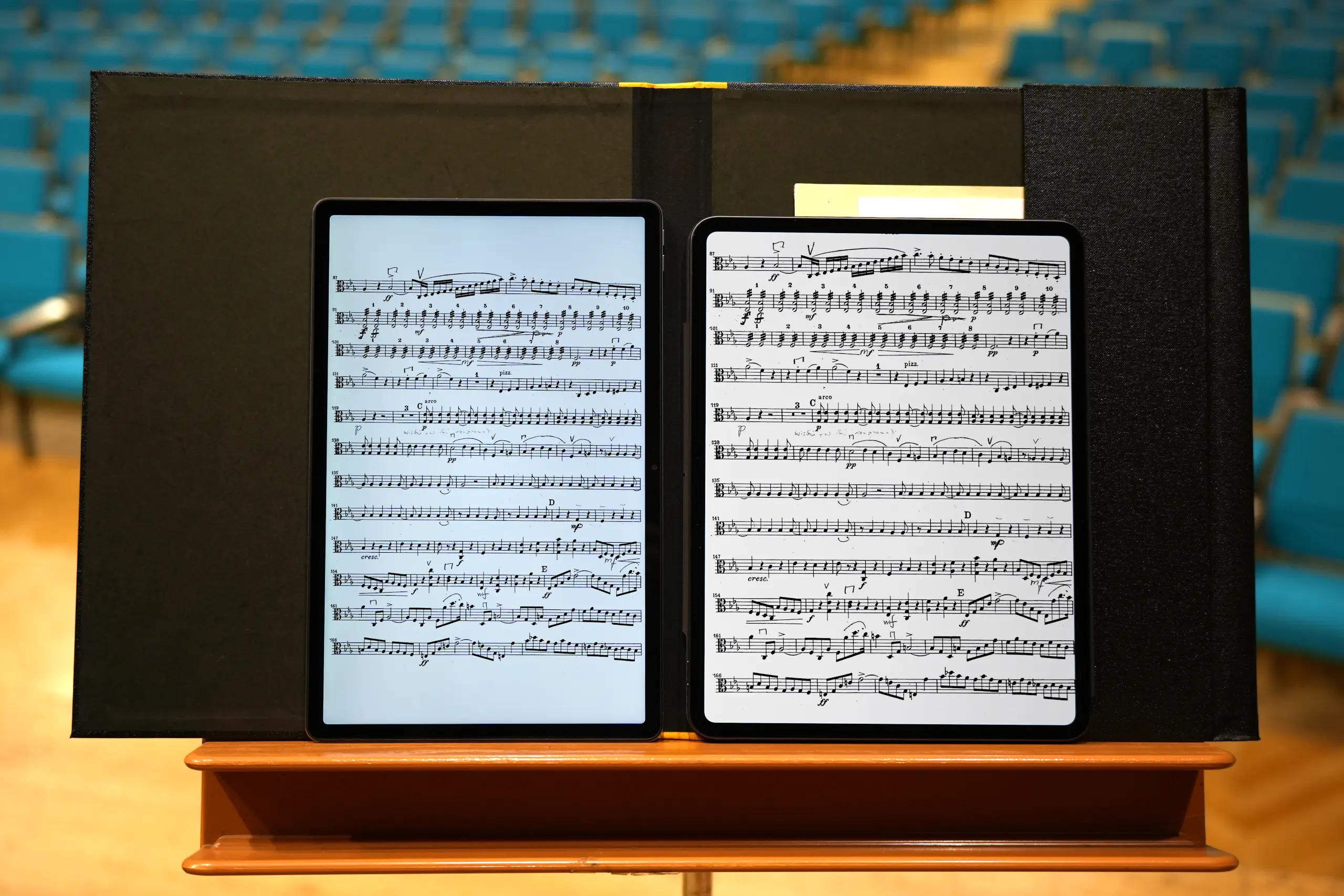
The Lenovo Tab P12 (left) is narrower than the iPad Pro 13. As you can see in the picture, my viola part is definitely smaller on the P12 than on the iPad. Photo: tablets-for-musicians.com
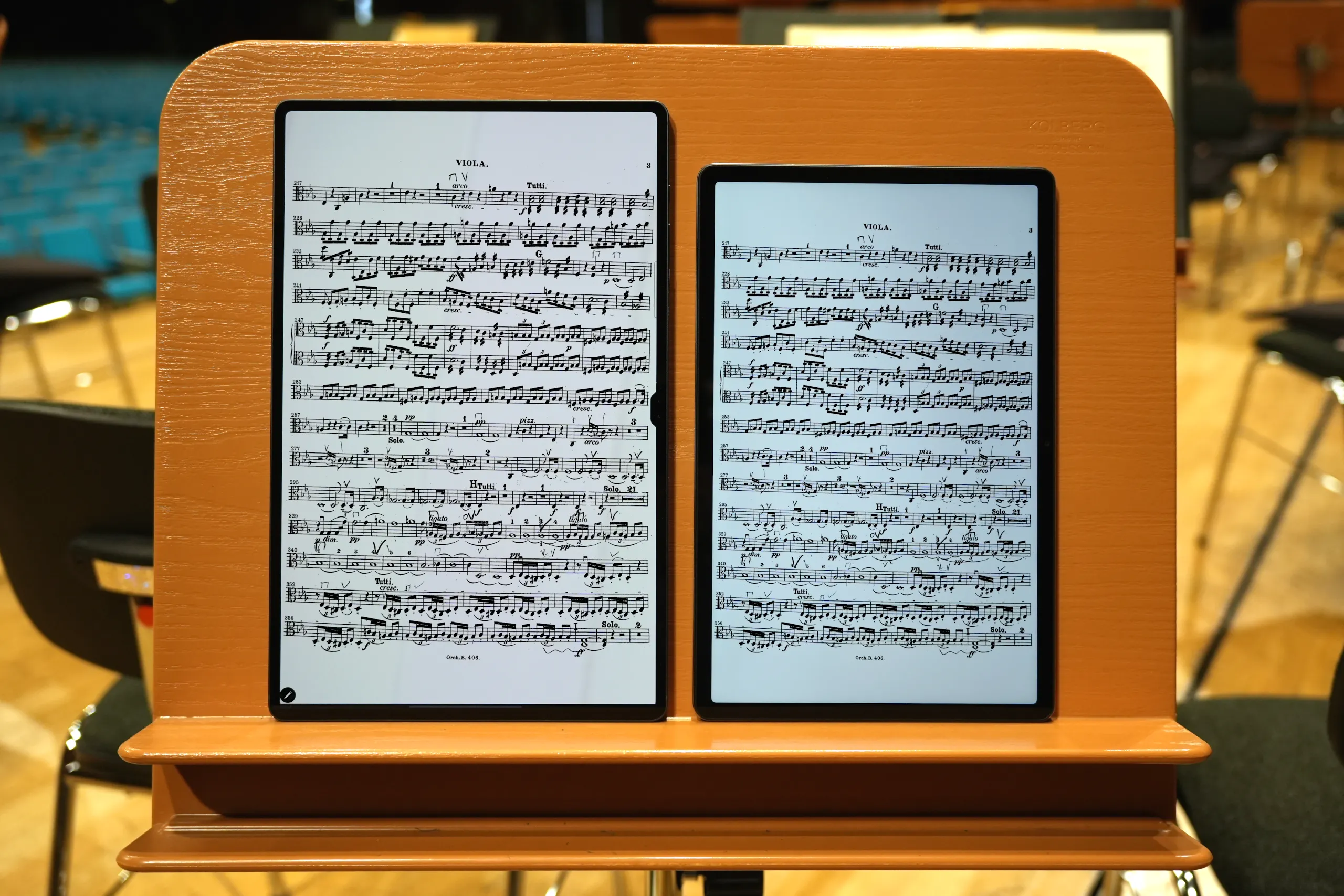
The Samsung Galaxy Tab S10 Ultra (left) dwarfs the Lenovo Tab P12, which is too small to read my part of Beethoven’s 5th piano concerto, at least when sharing a music stand. Photo: tablets-for-musicians.com
- The maximum brightness (important when playing outside) is around 407 nits (cd/m²) on the P12 and 619 nits on the Galaxy Tab Ultra. This is not a problem in everyday life when practicing, but can be decisive when playing outdoor concerts.
- There is no 5G (cellular) option on the Lenovo Tab P12. Not everyone needs mobile data on their tablet, but if you are constantly on tour, the option to be independent of Wi-Fi is definitely worth considering.
- The length of support and security updates. The Lenovo Tab P12 was launched in July 2023 and will only be upgraded to Android 15 and get security updates until June 2027 (four years after the worldwide release) – see source. On the other hand, the Galaxy Tab S10 Ultra, launched in October 2024, will get upgrades at least up to Android 18 and seven years of security updates, i.e., until October 2031!
Note that both the computing power and the screen resolution of the Lenovo Tab P12 are absolutely sufficient for reading sheet music. It is definitely suitable for practicing, rehearsing and playing concerts as a musician (even as a professional), if you are ready to accept a display that is much smaller than printed sheet music.
3. Windows tablets
Microsoft Surface Pro
Microsoft has several Surface Pro tablets / laptops with detachable keyboards available. These 2-in-1 devices can be very interesting for musicians, as they can be used as a laptop (in our case, to run music software made for Windows) or as a standalone tablet (to read sheet music). Here is an overview of the available models:
- The Surface Pro 11, released in June 2024, is the first Surface Pro Copilot+ PC, which means it will support all the new AI features coming to Windows. This generation comes with a Snapdragon X processor by Qualcomm, which may result in slower performance when running software made for Intel and AMD processors.
- The Surface Pro 10, released in April 2024, is targeting business customers, but can be ordered by private customers via the Microsoft website. It features the latest Intel Core Ultra processors and is very similar to the Surface Pro 11.
- The Surface Pro 9 was released in October 2022, which means it has already reached the first third of its life cycle. Since Microsoft promises six years of driver and firmware updated for Surface devices, official support for the Surface Pro 9 will end on October 25, 2028. On the positive side, this also means that you may find great discounts.
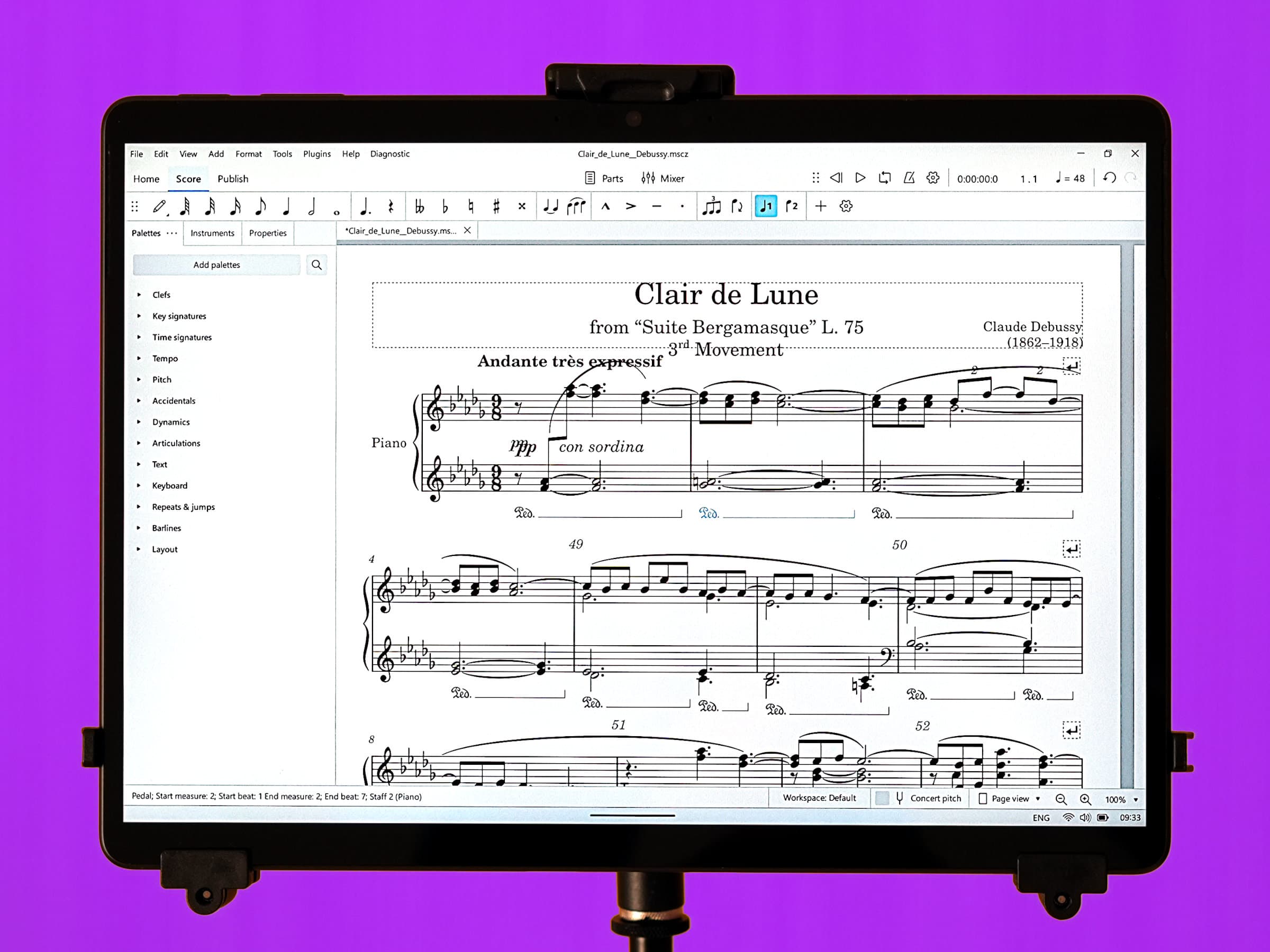
Editing music with MuseScore on the Microsoft Surface Pro. Photo: tablets-for-musicians.com
Is the Surface Pro a good tablet for reading sheet music?
Absolutely! The Surface Pro series features a large 13-inch display with a 3:2 aspect ratio, making it a great choice for displaying and annotating sheet music.
My favorite application for reading sheet music, MobileSheets, is available as a native Windows application in the Microsoft Store.
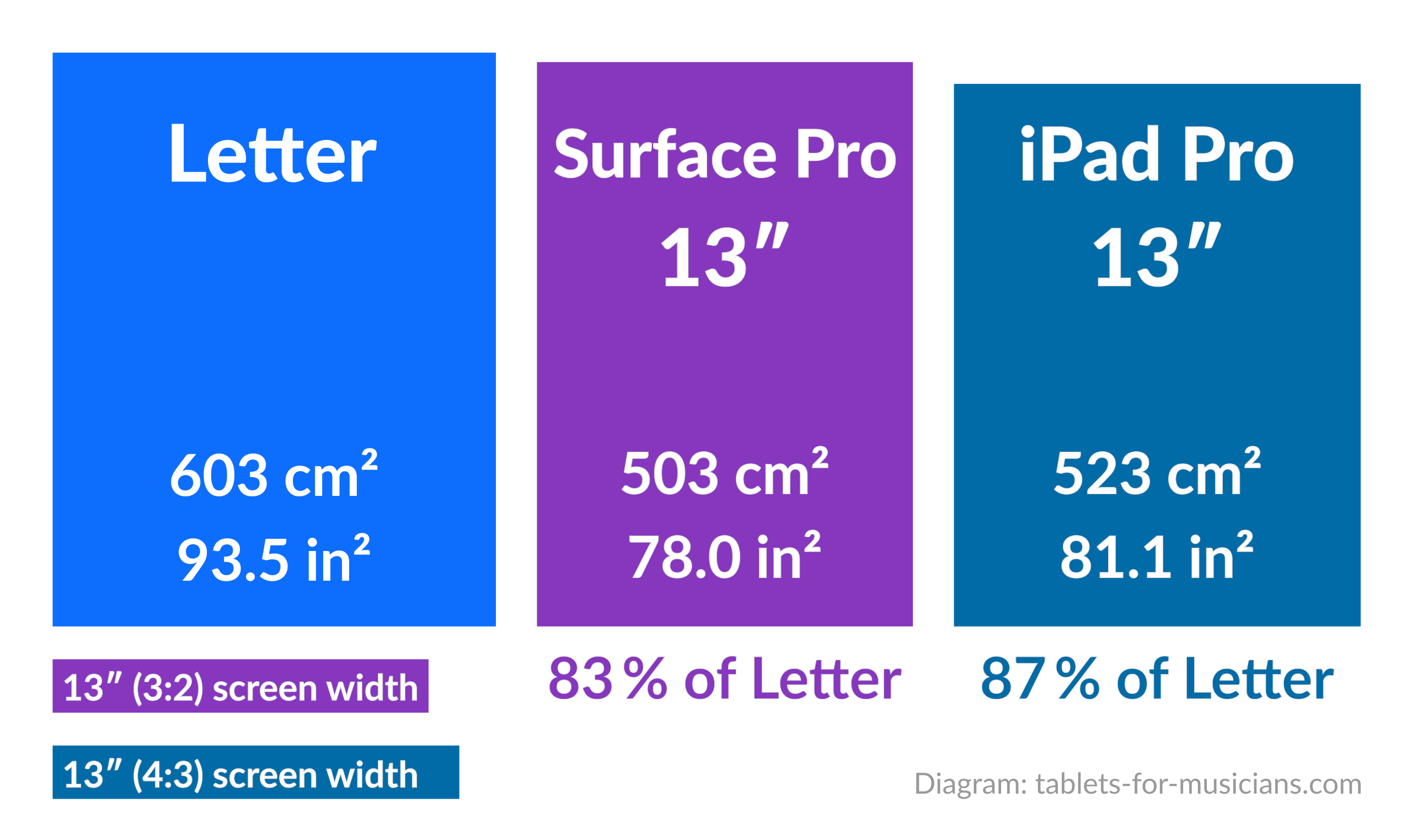
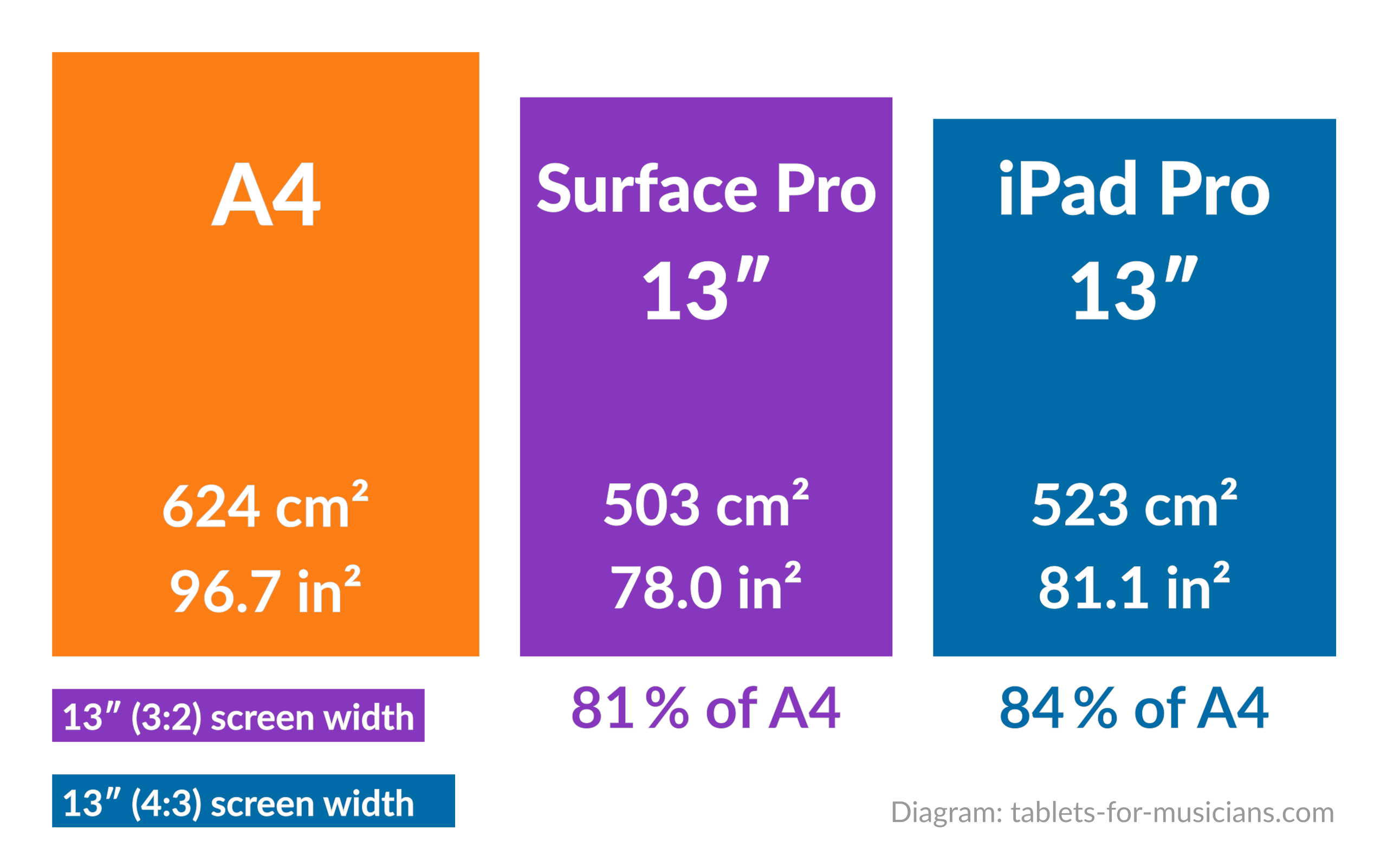
While the screen area of the Surface Pro is slightly smaller than that of the 13-inch iPad models, its 3:2 aspect ratio is more suited to reading sheet music.
The superpower of Windows tablets: software diversity
The Surface Pro series does not run Android, but Windows 11. A powerful mini-PC is hidden beneath its tablet look. Unlike iPads or Android tablets, a Surface Pro is therefore not limited to mobile apps.
In addition to apps like MobileSheets (for reading sheet music) and various metronomes and tuners, the Surface Pro is capable of running real Windows software.
Music notation software
The professional music notation programs Sibelius, Finale and Dorico run in their full Windows version. For comparison: these are entirely absent from the Android platform, while iPad users will only find a simplified version of Sibelius and Dorico.
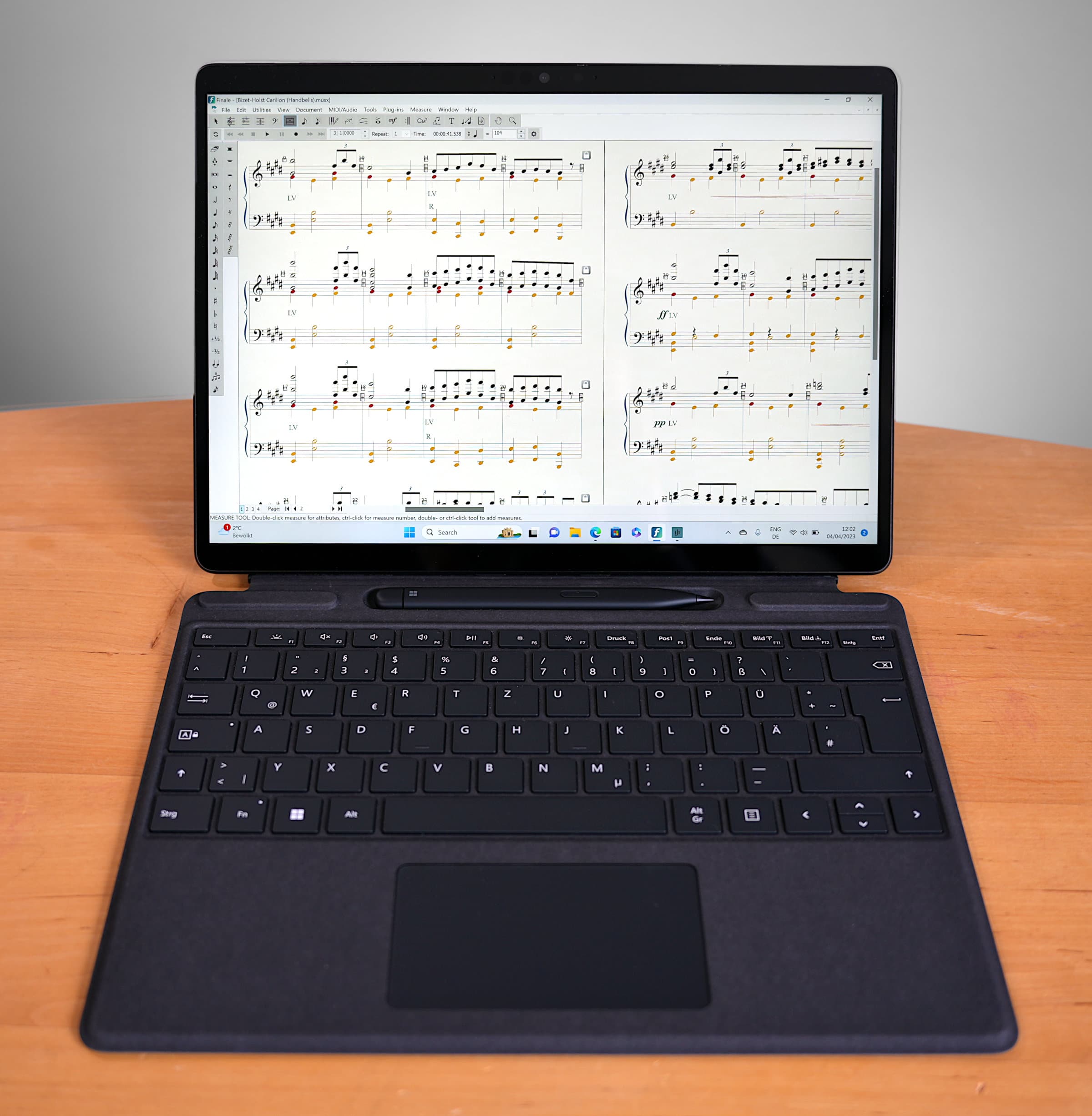
Windows tablets are the only ones that can run the Finale music notation software (here on the Surface Pro 9). Photo: tablets-for-musicians.com
Musescore is also available in its full version. This version allows full playing and editing of parts and scores, while the mobile apps (for iPadOS and Android) only allow music reading and transposing, not editing.
Digital Audio Workstations (DAWs)
Cubase or Ableton Live can be used in their full version on the “Surface Pro” series. These programs are not available for either Android or iPadOS.
However, according to Notebookcheck, the latency of the Surface Pro 9 is relatively high (1942 μs), which is not ideal for recording. However, it is possible to reduce latency and optimize Windows for audio recording.
Stylus and keyboard
Like Apple, Microsoft does not include the stylus (dubbed “Surface Slim Pen 2”) with its high-end tablet. As it is essential for writing your fingerings, bowings and dynamics, you will need to purchase it separately. It is much more enjoyable to use than the Samsung S-Pen, but I slightly prefer the Apple Pencil.
Usually, a keyboard is not included with the Surface Pro. Microsoft has a few different models, the most recent and expensive is the “Surface Pro Flex Keyboard”. I tested the “Signature Keyboard”, which was excellent (fortunately, considering its price), but its “plush” finish tended to attract dust.
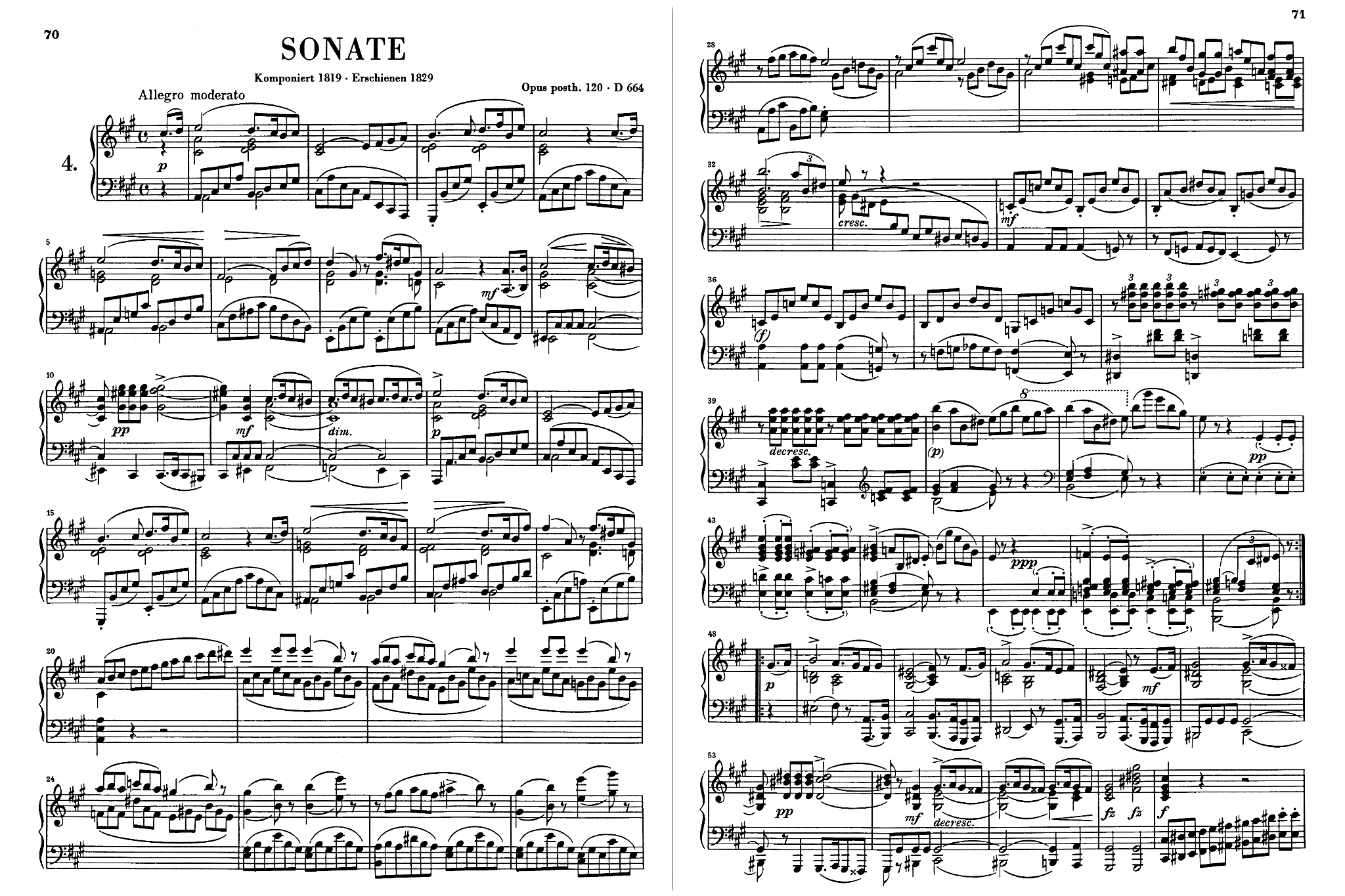
Screenshot of Schubert’s Piano Sonata in A major (D. 664) on the Surface Pro in landscape mode.
Surface Pro: Pros
- Excellent display for working indoors
- 3:2 aspect ratio, ideal for sheet music
- Full-fledged Windows 11 PC
- Supports full software versions (Sibelius, Finale, Cubase …)
Cons
- Glossy, highly reflective display
- Slow waking up from sleep mode
- Limited choice of mobile applications
- Active cooling, occasionally audible fan
- Less convenient than Android or iPadOS tablets
Surface Pro verdict: an excellent solution for musicians using Windows software
If you’re looking for a single device to serve as both a laptop and a tablet, the Surface Pro is for you! As a laptop, it will make most users happy. As a tablet, it is certainly a little heavy, but well proportioned and very pleasant to use.
On the other hand, if you already have a laptop and are only looking for a device to practice, rehearse and perform, a Surface Pro is probably not the best choice. It’s less convenient than an Android tablet or an iPad, and the range of mobile apps is more limited.
Tablets for musicians: conclusion
After many years of unchallenged dominance, Apple’s iPads are no longer the only recommendable tablets for making music. In 2025, the tablets of the competition are excellent, and in some aspects, Samsung’s and Microsoft’s flagships even surpass the iPad Pro.
As a musician, picking a tablet is very complex, because it’s as much about choosing hardware as it is about choosing a software platform. Let’s summarize:
Apple iPads
- Hardware: Although iPad screens don’t have the ideal aspect ratio for sheet music, Apple iPads (and especially the iPad Pro) are exceptional in quality and performance, and the stylus is outstanding.
- Software: Apple still holds exclusivity for several mobile applications, such as forScore, Newzik, Ableton Note and GarageBand. However, some of these apps are only available in a feature-reduced version, such as Dorico or “Sibelius for Mobile”.
Android tablets
- Hardware: The Samsung Galaxy Tab S10 Ultra is the best Android tablet for musicians. The huge display, split screen functionality and superfast charging make it a great workhorse, on a par with the 13-inch iPad Pro.
- Software: Android’s maturity on large-format tablets is now beyond doubt. They’re super-responsive and easy to use. And when it comes to score-reading apps, MobileSheets has not much to envy to forScore. Still, the choice of music apps is more limited than with Apple.
Windows tablets
- Hardware: Windows 2-in-1 devices are both a laptop and a tablet. If you only want to own a single device due to space, budget or environmental reasons, this is the best solution.
- Software: For using as a laptop and especially for using scorewriters such as Sibelius, Finale, Dorico or MuseScore, Windows 2-in-1 devices are an excellent option. But unfortunately, Windows does not shine in tablet mode. If you’re primarily interested in reading sheet music, an iPad or an Android tablet are a more convenient alternative.
Can't make up your mind?
Are the arguments listed above too obscure and the decision seems too complex? There is a very simple way to choose a tablet, and it depends on your mobile phone:
- If you use an Android phone (Samsung, Xiaomi, Oppo, etc.) and are happy with it, choose an Android tablet. Now all you have to do is install MobileSheets (via the Play Store) to start reading sheet music.
- If you own an iPhone and are happy with it, choose an iPad Pro. Install forScore via the App Store to start reading sheet music.
This way, you will already be familiar with the interface, and it will be easier to get started. However, consider this method as one argument among others: it is entirely possible to use an Android tablet for music if you have an iPhone, and vice versa.

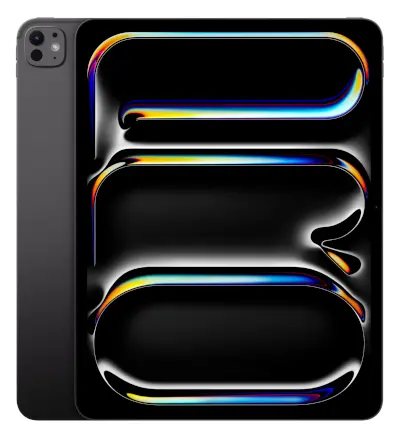
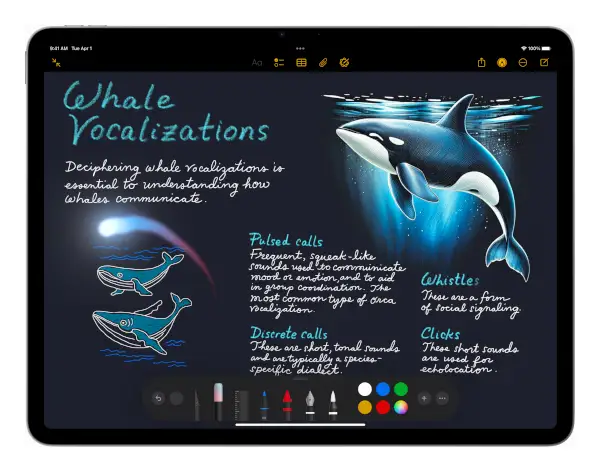
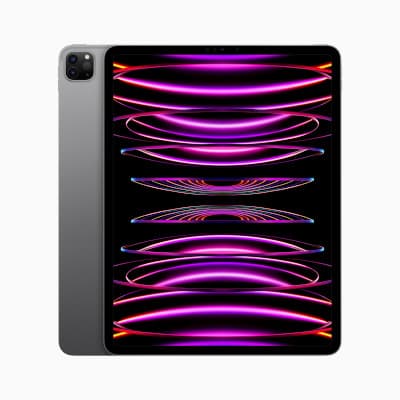
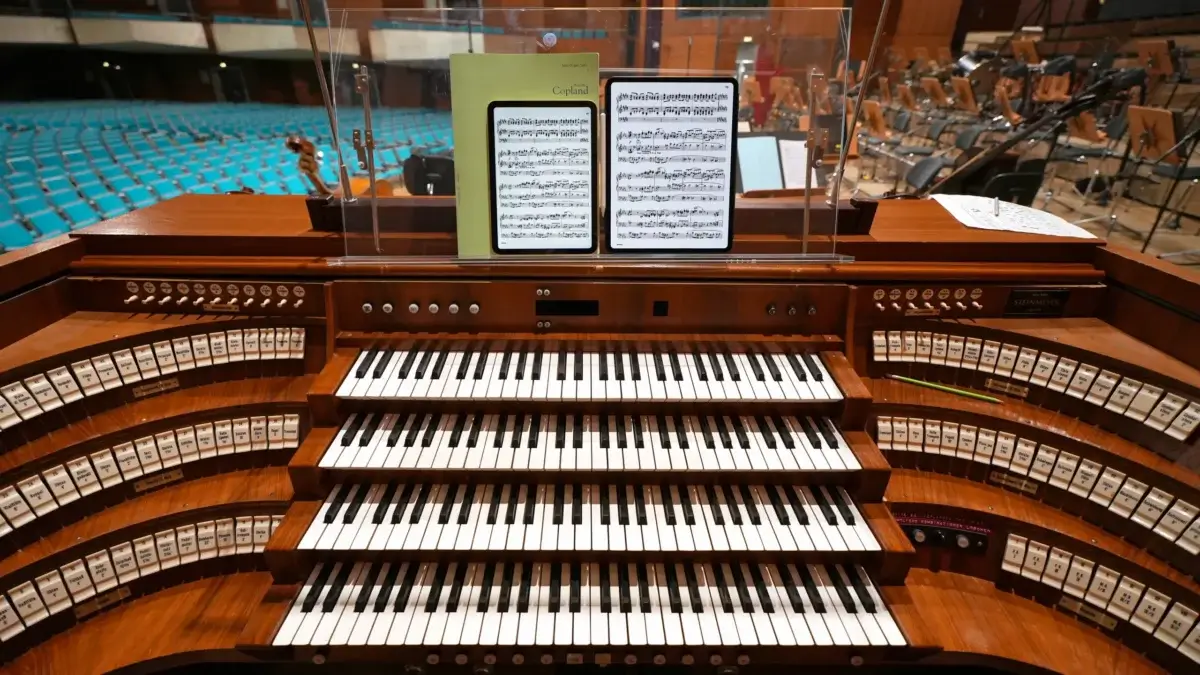
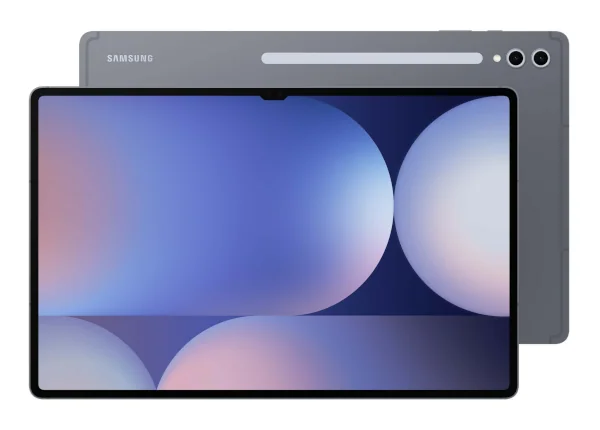
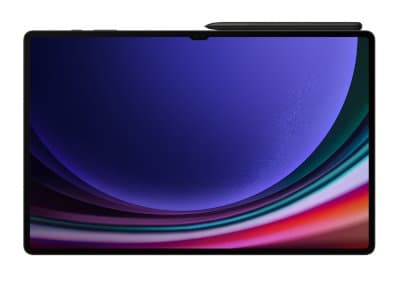
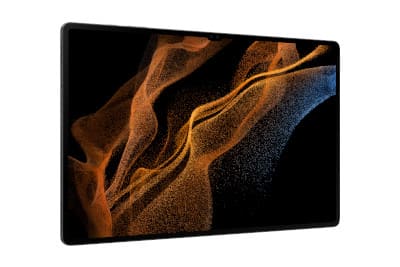
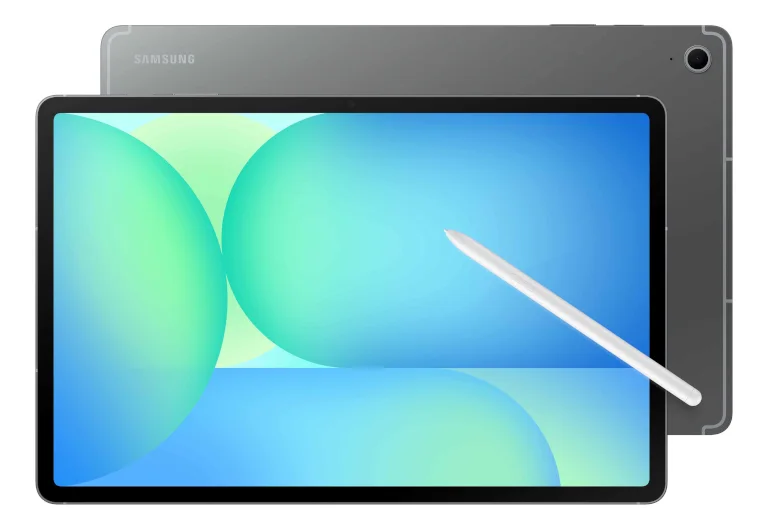
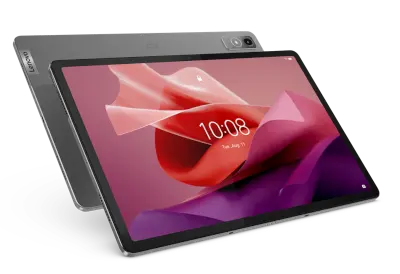
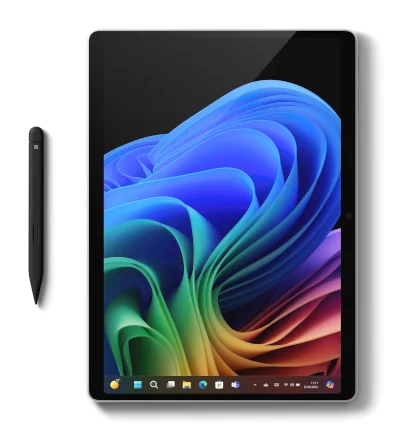
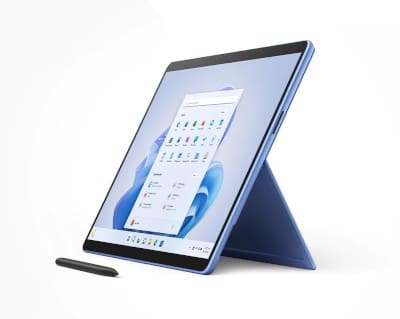
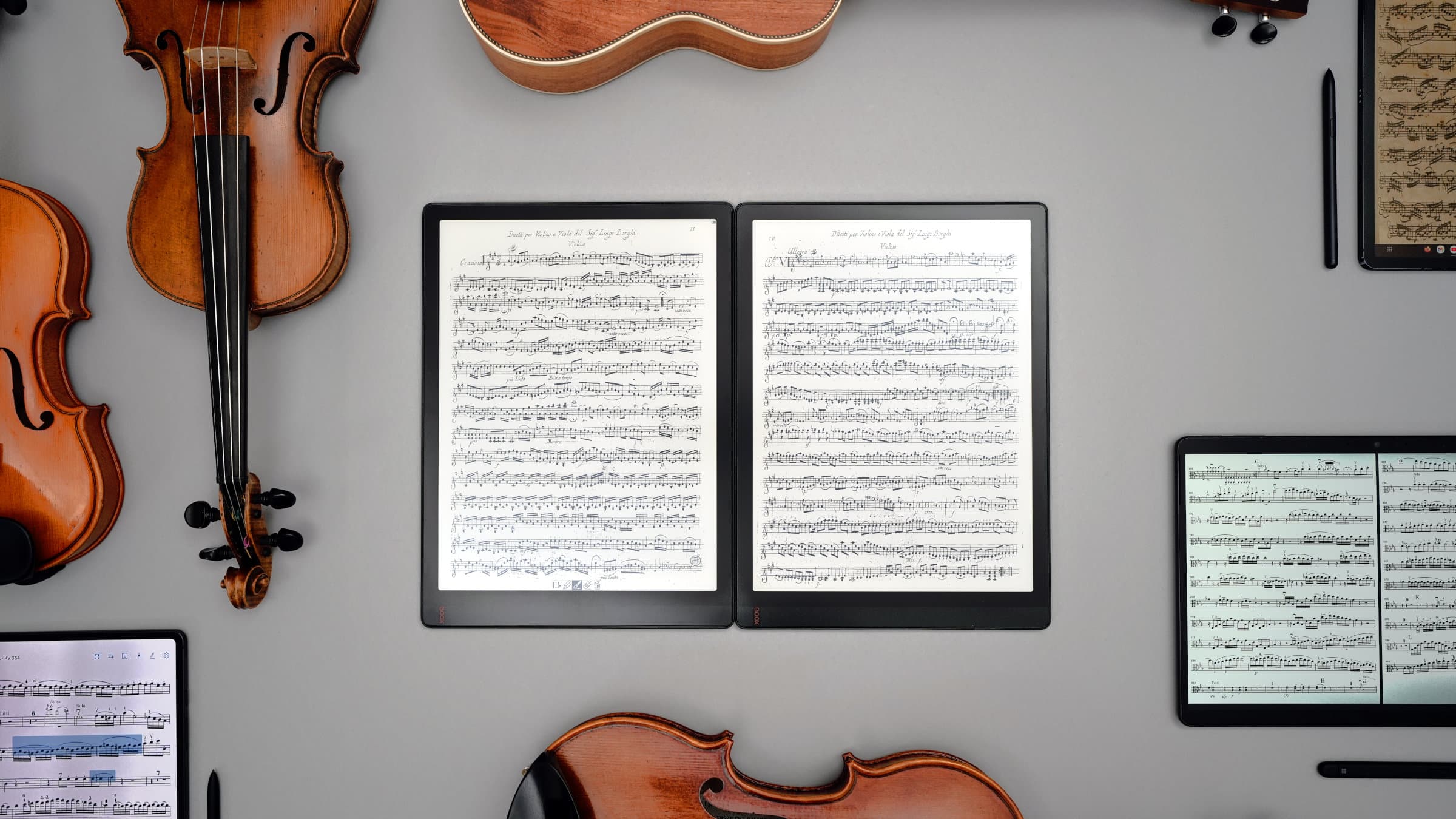
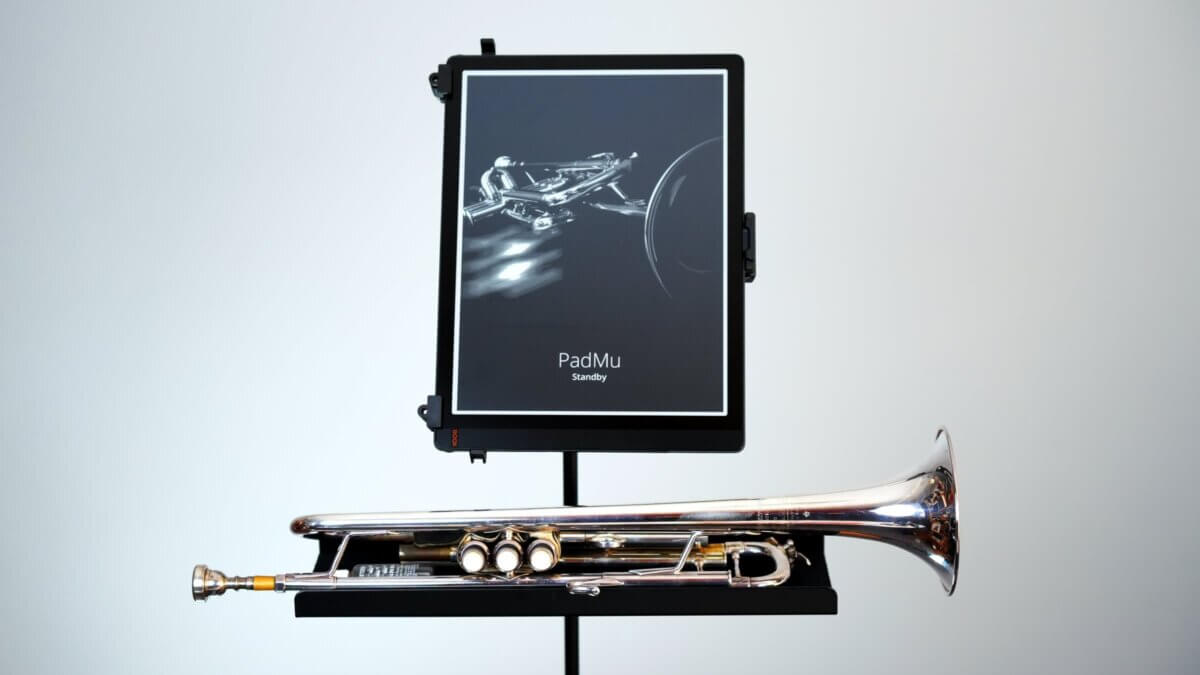
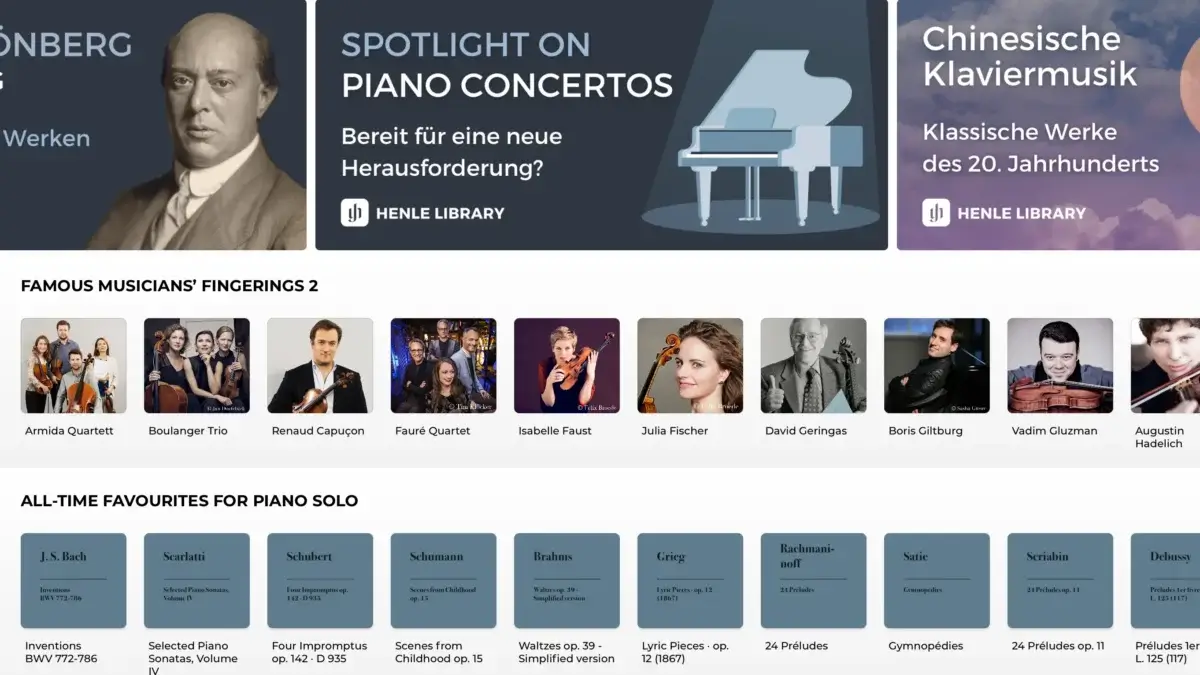
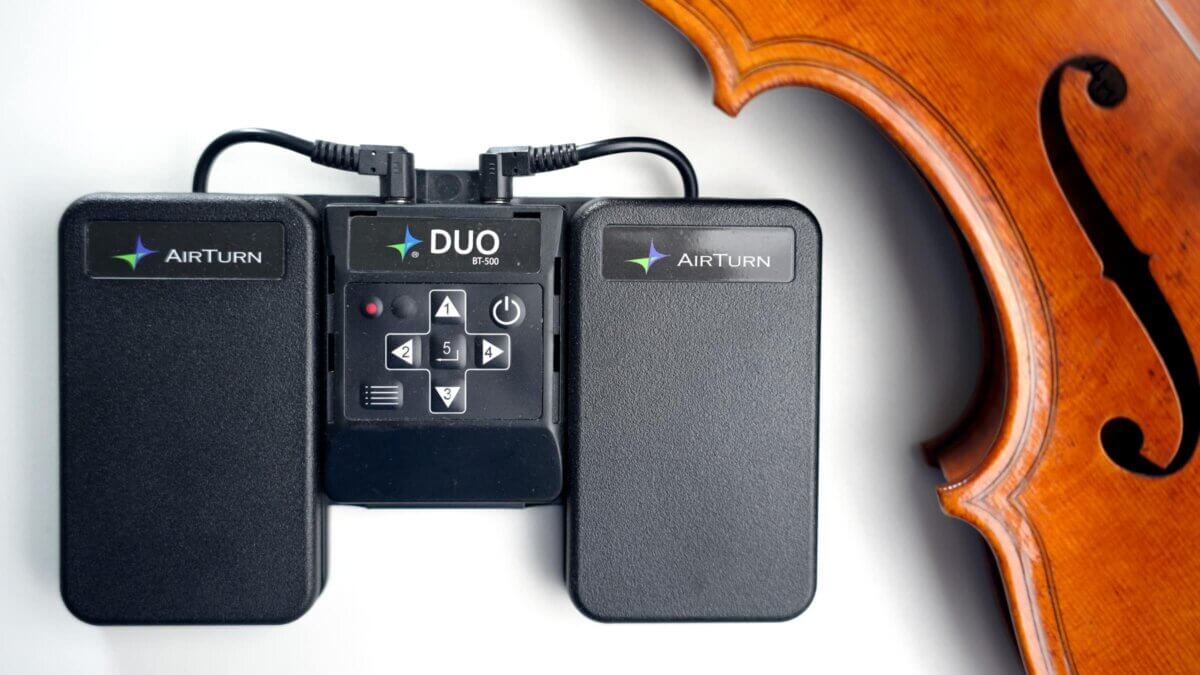
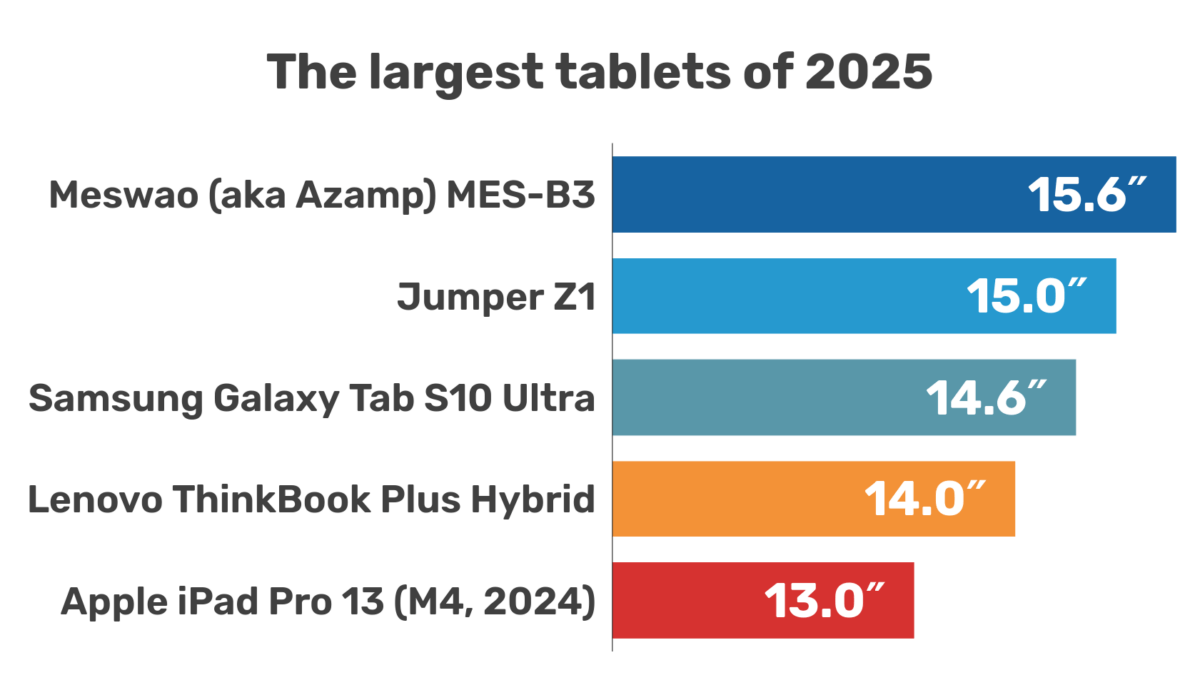

40 thoughts on “The best tablets for musicians”
Can you recommend stands that would fit a Samsung Galaxy S10 Ultra? And along those lines, it would be great if you had a page for “the best stands”, similar to your page for “the best page turners”.
Many thanks, Bruce, for your very kind comments! I corrected the letter paper percentage error, I must have been tired when I made the chart.
I’ve been planning an article on tablet music stands for more than two years, but it’s never the most urgent thing, so I keep putting it off! I have already tested quite a lot of them and I now plan to write the article in June.
There are two stands that I can recommend for the Samsung Galaxy S10 Ultra:
This one is easy to use, rotates, and fits the Galaxy Tab Ultra series with or without a case (and even thick cases work). Note that you won’t be able to attach the S-Pen to the back when using the stand.
I call this one the “triangular” stand. I like it too, but tablets will only fit without a case, or with really thin cases. Single-sided TPU/silicone covers do work. The maximum thickness is 0.43 inches (11 mm) according to the specifications (tablet + case). With this stand, you can still attach the S-Pen to the back, but you have to put the tablet upside down (which has no real drawbacks)!
I hope my answer didn’t come too late. Cheers!
Johannes
Hello Johannes,
Thanks for a great set of pages! I got all excited when I saw sample screenshots showing the alto clef! (I too am a violist). I noticed a fairly minor error on this page: in the diagram for “Surface Pro vs. Letter”, you actually show the screen sizes relative to A4 as opposed to letter. You can fix this when you need a break from practicing! 🙂
I’ve been waiting for tablet screens to get big enough for me to consider them usable. Based on what I read here, I think I am leaning towards the Samsung S10 Ultra. I’m an iPhone user, but also a software developer for over 40 years so different platforms don’t scare me. I typeset a lot of music (Finale) and I generally publish on a 9×12 inch page size. If I strip off margins, I compute that pages would fit on the Samsung with a scaling of 91%, which I think is fine. I haven’t checked on any prices yet; hopefully they will not give me cardiac arrest! Thanks again for your very valuable reviews.
Are there any solutions for conductor scores? These are often A3 and can’t be displayed well enough on a standard tablet.
I know it is possible to combine 2 iPads with Forscore but this is for displaying two pages as far as I could see. Is there a solution where one uses two ‘screens’ (brand doesn’t matter) where the upper half of the score shows on one tablet and the bottom half on the bottom one? Or is there maybe a solution with one screen large enough to show A3 in full size?
Very large displays are indeed very useful for orchestral scores! There are three *foldable* tablets available – unfortunatley they are all super expensive. All three run Windows, are very similar in specs and have really large 16 or 17-inch screens (when unfolded). They’re also in their first generation, and I’ll try to review at least one of them when (and if) second-generation devices are released. In the meantime, here are the available models:
I am an older musician (pianist) and my eyesight is no longer good. I use paper music in landscape mode, showing about half a page at a time. Can I do the equivalent on an iPad — use landscape mode but just showing part of one page at a time?
Hello, Jean,
Yes, it is absolutely possible to use any iPad in landscape mode to show only half pages. Depending on the settings of the sheet music app, you can scroll the page or turn half pages.
The sheet music is then very large, and it is even larger on the Galaxy Tab S9 / S10 Ultra or the Lenovo Tab Extreme.
Hi again!
Thank you for your answer.
Do you believe three 5G version of a tablet (S9 ultra or S8 ultra) is a must have or the WiFi version is good enough?
We are talking for big and heavy tablets and if needed, the WiFi version can be tethered with my phone.
It’s difficult to answer if cellular support, also known as 5G is needed. I think that it really depends on whether you need to download and prepare your scores when you’re at home (using WiFi) or on the go (using the cellular network).
In my case, I almost always download my scores on my tablet / iPad when I’m home, and I almost never use 5G. The next tablets I’ll buy will probably be without cellular support, then I don’t have to care about plane mode or muting incoming calls during rehearsals or performances.
Hello!
What is your opinion for using the Samsung Galaxy Tab S9+ / S10+ with its 12.4-inch screen with MobileSheets?
Is it large enough?
I am interested because it’s much lighter and portable than his S9 / S10 Ultra brother.
Hello, Yannis,
The Samsung Galaxy Tab S9+ has a 16:10 display ratio. Its screen diagonal is 12.4 inches, but in reality, its screen area is much smaller than a sheet of paper:
It is much smaller than the S9 Ultra, but also much smaller as the 12.9 or 13-inch iPad Pro and 13-inch iPad Air, the latter being:
To read sheet music (with MobileSheets, the IMSLP app, MuseScore, …), I would rather use an older Galaxy Tab S8 Ultra than a newer Tab S9 Plus.
I hope this helps!
How bad is the display of the Samsung for outdoor use? I’m thinking about playing music off of a tablet in an outdoor community summer band, so that way I don’t have to deal with music flying all over the place – nor clothespins. Does the gloss really stop a musician from being able to read the notes?
Thanks!
Hello!
The Samsung’s display is not bad at all for outdoor use! I played many outdoor concerts with the S8 Ultra, and then the S9 Ultra, and the gloss wasn’t an issue for me (you can turn the display or the stand around a little to prevent it). In full sun, the problem is more the maximum brightness that the display is able to achieve. There are situations (when the tablet is in direct sunlight) where it really gets difficult to read if the display is not bright enough. To be problematic, the sun has to be shining directly onto the tablet, and any stage or shading is sufficient to prevent it.
By the way, the Samsung’s display reaches 620 nits of brightness, which is even a little brighter than all Apple tablets (which includes the 12.9-inch iPad Pro and the 13-inch iPad Air), except the new 13-inch iPad Pro which is by far the brightest tablet available and reaches more than 1000 nits (values for SDR content).
In any case, avoid any tablet with a maximum display brightness under 500 nits !
Hello,
I am writing this e mail regarding the best tablet for piano duet.
I am a pianist and piano duet and I m looking for a digital solution for scores.
Could you please recommend me the best tablet for scores piano 4 hands?
Thank you in advance!
Hello KP,
even the biggest tablets are still small for piano 4 hands, and you’ll have to turn pages quite a lot. Which tablet is the best depends a lot on if you want to play with the tablet in portrait or landscape orientation.
I hope this helps!
Johannes
What about the new iPad Pro: in 13” with nano-texture glass? Is this The One?
Hi, Gerrit!
I ordered the new 13-inch iPad Pro AND the new 13-inch iPad Air to test them, but unfortunately I won’t be able to test the nano-texture glass version (simply too expensive). I really wonder if the 13-inch iPad Pro is really worth its super high price tag for sheet music, or if the new 13-inch iPad Air is good enough for this purpose. Real-life testing will take some time, though!
Cheers!
Thank you for this wonderful resource! I would be interested in if you have a specific recommendation or thoughts on tablet stands. I see in your photos that you have specifically a tablet stand, maybe you have one in particular to recommend.
Hello,
I love tablet / iPad stands and have tested 5 different models. They are really great for chamber music / choirs / bands as they take up less space on stage and the audience can see the musicians better.
In most of the pictures on this website, you can see the following tablet / iPad holder from K&M, which is my favorite:
There is also a version without the stand itself: the holder alone can be screwed onto any tripod or mic stand with a 3/8-inch thread:
The Galaxy Tab Ultra S8, S9 and S10 as well as the iPad Pro models fit on the holder, but (please note!) only without a cover or with thin covers (typical TPU / silicone covers, not with thicker “folio” covers). The official Samsung folio case (“Book Cover”), which is very thin, just fits in terms of thickness. The maximum thickness is 0.43 inches (11 mm) according to the specifications, in reality a tad more.
For iPad / tablets with normal, foldable covers, I would recommend the following tablet stand:
Here also, there is a version without the stand itself (tablet holder only):
For everyday use, prefer the second solution, as it is compatible with most protective cases.
Best regards!
Hello and thank you for your detailed articles on the various options available to us musicians!
I would like to get more information about the sustainability, durability and lifespan of each tablet. Are the e-readers and the Microsoft Surface Pro 9 more durable? For me, such an expensive device is only worth buying if I can use it for ten years or so…
Kind regards!
Hello!
The question of sustainability and lifespan of tablets is very important to me, and I will try to write an article about it soon (also about the CO₂ footprint of using tablets vs. printed sheet music).
Here’s a short answer: it’s hard to know exactly how long a tablet will work. Even after the official support period ends, a tablet can remain usable for many years. If you take the official support period as a reference, this is what you get:
Apple iPad: The first generation iPad Pro 12.9 was launched in September 2015. Eight years later, iPadOS 17 was released with no support for that device. Still, there will be security patches for iPadOS 16, but over time the old iPad will work less and less well. You can expect it to be usable for almost 10 years, although the battery will in all likelihood need to be replaced at some point.
Microsoft Surface tablets: Microsoft’s The Surface Pro 4 was released at the same time, in October 2015, but support ended in January 2021, after more than five years. Support for the Surface Pro 5 (released 2017) ended in January 2024, after 6.5 years. According to Microsoft’s new update policy, new Surface Pro models should be officially supported for at least 6 years. But Windows will certainly continue to run for many years after the end of support.
Samsung and Android tablets: Samsung’s first large flagship tablet, the Galaxy Tab S8 Ultra, only came onto the market in spring 2022. So there are no reliable empirical values on real life security support yet. Samsung promises four generations of One UI and Android OS upgrades and five years of security updates for its high rage devices. This is short compared to Apple and Microsoft, but very long for Android devices. Lenovo, which makes the second-biggest tablet, promises only three Android versions and four years of security updates for its Tab Extreme, and this is already more than most other Android manufacturers.
So your best bet when it comes to tablet longevity is probably an Apple tablet. The good news is that sheet music reading apps don’t require particularly powerful hardware. This means that newest models will probably be able to run, for example, forScore, Newzik or Mobile Sheets in 10 years. But also that refurbished or used tablets are able to run sheet music software and therefore are an option to consider. I hope this could help!
Sources:
Apple: iPad models compatible with iPadOS 17, iPad models compatible with iPadOS 16. Here you can see that 10 years of support can be quite possible: Apple iPad on endoflife.date
Microsoft: Surface devices driver and firmware lifecycle, Which Surface devices can be upgraded to Windows 11?
Samsung: Samsung: Announcing up to five years support for Samsung Security Updates on select Galaxy devices
Lenovo: Android Upgrade Matrix, see “The Security Updates EOL for all products” at the bottom of the page
Hello,
I am currently searching for reader software myself and came across MusicReader It has an automatic page turn timer. I haven’t tried this function, but it may help organists. They offer a 30-day free trial.
Best of luck!
I am trying to decide between MusicReader and MusicSheets so if anyone has experience with these 2 platforms I would love to hear your experience. I will be using a Microsoft Surface Pro 7. I will probably get a 13″ iPad at some point in the future, but since I already have the Surface Pro I will use that.
Thanks!
Hi, Eric,
thank you for your comment, I never stumbled on MusicReader before, so I’m happy you mentioned it. There are not many cross-platform sheet music app that support all major platforms. Beside MusicSheet and MusicReader, you could also try Dimusco. I have not tried MusicReader yet, but will certainly do so in the near future. Cheers!
Thank Johannes! I haven’t seen Dimusco before. I will look into it.
I noticed you didn’t mention Piascore. I’m quite surprised, because I’ve been using it for many years on my iPad, and I’m very happy with it!
Hello Michael,
Piascore is a digital score-reading application developed in Japan, and is one of the most widely used in the world. Just like forScore, Enote and Newzik, it is only available on iPad and iPhone.
In early 2018, Piascore reached over 10 million downloads. At the time, most users came from the USA (37%), Japan (23%) and China (16%). According to Piascore’s own description on the Apple App Store, the app currently has 4 million active users.
Unfortunately, the development of Piascore seems to have slowed down considerably, or even stopped, since 2019.
This is unfortunate, because Piascore is one of the few free sheet music reading apps (although some features require to be purchased within the app, such as the recorder, the tuner, and exports via AirDrop). It’s also almost the only app (along with forScore) to offer page-turning via face gestures, which is very useful for organists or harpists who can’t use foot pedals to turn pages.
I hope the development of Piascore will resume soon. In the meantime, it’s not a future-proof solution, and I prefer to recommend the applications mentioned above, or MobileSheets, which has the advantage of also being available for Android and Windows.
Good morning,
Your analyzes are very well done and relevant, thank you. I bought the Galaxy Tab S8 Ultra, which I use with MobileSheets with its PC companion software. (There is only one thing that I would fix: the tablet is not only unusable outdoors, but also as soon as there is a window behind you… It seems that there are anti-reflective filters available…)
I have a question about importing my scores to MobileSheets, which can be a heavy workload, what do you use?
For the moment, I scan on an all-in-one printer (photocopier-scanner). It’s not easy to fit in the A4, you have to position it correctly. Then, I edit my scores by hand: enhance contrast, rotate, eliminate my manual notes (or not). I’m told that there are smartphone apps that do all the work automatically from photos, I couldn’t find any free ones.
Hello Kristop,
I’ve used the Samsung Galaxy Tab S8 Ultra for plenty of outdoor gigs, and found it to be quite usable in almost all cases. For having compared it many times directly in the bright sun to my 12.9-inch iPad Pro (2021): the brightness and readability of the scores is even a tad better on the Samsung tablet than on the iPad.
But if you play a lot of concerts outdoors and especially in direct sunlight (e.g., if the stage has no roof), the displays on e-readers for musicians are incomparably better, but e-readers have other drawbacks.
When it comes to digitizing sheet music, having tested several mobile applications, I can recommend Adobe Scan (available on Android via the Google Play Store and on the Apple App Store). The app is free for standard use and allows you to export PDFs of scanned music scores.
However, scanning sheet music on a real physical scanner (in 600 dpi if possible) or a multi-function printer gives better results. And above all, the result does not depend on the ambient light, the shadow of the smartphone or tablet, the phone’s flashlight, etc.
Happy scanning!
About two years ago, moved my 10 piece jazz / swing band to tablets. I prepared two YouTube videos which outlines how to do this and choosing tablet – low cost!
Sheet music on tablets (for bands) – choosing tablets:
http://www.youtube.com/watch?v=ew_rfKj9djY
Sheet music on tablets: format PDF for easy reading on tablets and iPads:
http://www.youtube.com/watch?v=9Mk6RPnIDYA
Thank you, Fred, for your comment and your videos!
Great article, thanks!
I’m currently using a Surface Pro 5 with PowerMusic Pro. They work very well together.
Although, the Surface Pro screen is starting to get a bit small for me and it seems the one needs to go with an All-In-One setup. PowerMusic Pro has these in various sizes in their hardware section, not software products.
Thought this might provide another point of view.
Cheers
Thank you, Carl, for your feedback!
The Surface Pro 5 was released back in 2017 and features a 12.3-inch display. Microsoft upgraded the Surface Pro series to a 13-inch-Display in 2019 with the first Surface Pro X, and 2021 with the Surface Pro 8.
I’m happy to hear that you’re still using the Surface Pro six years after its release – it speaks for good hardware quality and a reliable software update strategy!
The next version of Surface Pro is expected to be released in October 2023. Wi-Fi models will likely be updated with Intel’s 13th-generation mobile processors. The 5G Surface Pro 10 (based on ARM processors) may feature a new Snapdragon 8cx Gen 4 processor.
For reading sheet music on a tablet, there is absolutely no need for a fast processor, though. Even older tablets will do the job.
PowerMusic is available on Mac, PC and for iPhone and iPad. I have never tested it, but it has excellent reviews on the Apple App Store and seems to be a good solution!
The UK-based company behind PowerMusic also sells digital 16-inch and 20-inch digital music stands. Check their website here:
Power Music Hardware Store
Hello
Thank you for your honest comparisons!
What do you think of a Samsung Galaxy Tab S7 FE? It seems interesting in terms of size and price.
Musical and digital greetings!
Hello Francis,
That’s a tough question! A year ago, it would have been easy to recommend the Samsung Galaxy Tab S7 FE. It was released in June 2021, two years ago. Samsung guarantees four years of security updates on this model, starting from the global release date.
The Galaxy Tab S7 FE is therefore halfway through its official lifespan. Samsung has not released an S8 FE in 2022, but a Galaxy Tab S9 FE seems to be planned and should be launched at the end of 2023. Its price is likely to be significantly higher than the S7 FE.
The S7 FE is the only 12-inch tablet in this segment and at this price, with the Tab S8+ costing almost twice as much! So the S7 FE is not a bad choice, despite its age. And since so many have been sold, I can’t imagine Samsung abandoning security updates altogether, even after the advertised 4 years of support.
Pros: 12.4-inch screen, update to Android 13, S-Pen included, DeX mode, SD-card support, excellent battery life.
Cons: only two years of support left, rather slow processor on the 5G model, 64 GB / 4 GB versions too low on memory.
There are two fairly different versions:
In both cases, if your budget allows, it’s best to opt for the 128GB or 256GB memory variants (which also come with 6GB or 8GB RAM, compared with just 4GB RAM for the 64GB versions). Here are the (affiliate) links to the models I’d recommend:
For sheet music reading apps like MobileSheets or Musescore, there’s no need for very fast processors, and even the 5G models should be sufficient.
I hope this helps!
Hi, how about padmu 4, do you recommend it? I’m a pianist and I love using books to study and have all my notes in them, but sometimes when I’m preparing new pieces I need to print them when I don’t have them in physical format. This is a waste of money and paper, I hate having paper all over the house!
Also, padmu has a dual-device version, quite nice for pianists.
What do you think?
Hi, Daniel!
I tested the PadMu 4 for several months, without being very convinced. The advantages for playing music outdoors are undeniable: the screen is readable even in direct sunlight, and the battery lasts a very long time. But the poor responsiveness of the screen makes me much prefer practicing with a good Android tablet or an iPad Pro.
My review of the PadMu 4 is finally out, check it out here:
PadMu 4 review: the best e-reader for musicians?
To turn the pages of a church organ, for example, you can’t use a pedal. Unfortunately, I still don’t know on which tablets it’s possible to turn pages by winking your eye, moving your lips or your head using facial recognition.
I know it works with forScore on iPad. But Apple is too expensive for me. I’d be grateful for a reply.
Hello HS!
Unfortunately, turning pages via face recognition only works on Apple tablets (and is called “Face Gestures” in forScore Pro and “Motion Detection” in Newzik).
MobileSheets (on Android and Windows) is planning to implement facial recognition, but the is no release date for this feature, so it could take a while.
There’s an Android app from Google called “Camera Switches” that lets you control the tablet using facial gestures. But this is not intended for turning the pages of sheet music, at least I couldn’t get it to work under Mobile Sheets.
An alternative page turning option would be the AirTurn Bite Switch Remote Controller. For some instruments, a mini ring remote control* might be a possible solution, but probably not for organ playing.
Until Mobile Sheets supports face recognition, the only realistic solution remains to get the most affordable Apple iPad you can find. Be careful when buying older models: not all iPads support “Face Gestures”! For example, “standard” iPads before the 8th generation are not supported, nor is the 4th generation iPad Air.
Models that support Face ID seem to be generally compatible with forScore’s facial recognition (see the official list of Face ID-compatible models) – although I cannot guarantee it.
I hope it helps!
Hello!
I’ve been working my way through your super interesting article. Unfortunately, I only understood half of it (I was born in 1963)! My problem is: I’m a complete page-turning dyslexic (the scores keep falling down!)
That’s why I need a tablet for my performances on the harpsichord (fragile music stand) that I can operate with a foot pedal. In addition, I should of course be able to write in fingerings in the parts with a pen. I am also a composer, and would like to be able to edit scores with Sibelius. Which tablet can you recommend?
Thanks a lot!
Hello!
Sibelius is not available for Android tablets and Chromebooks, so these device categories are out. You are left with the following two (excellent) options:
As for fragile music stands: the iPad Pro 12-inch weighs 1.41 lb, which is lighter than the 2-in-1 devices from Microsoft (1.94 lb) and Dell (from 1.60 lbs) – weight without keyboard.
Personally, I would edit sheet music and scores on a desktop computer (with a larger screen), and prefer an iPad for reading sheet music and occasional Sibelius edits.
As for turning pages, all of these devices are compatible with Bluetooth page turners. My favorite pedals are the Airturn Duo 500* (compact, charges like a cell phone) and the PageFlip Butterfly* (works on two AA batteries, the on/off switch is better).
Best regards!